Pioneer AVIC-5200NEX, AVIC-6200NEX, AVIC-7200NEX, AVIC-8200NEX Operating Manual
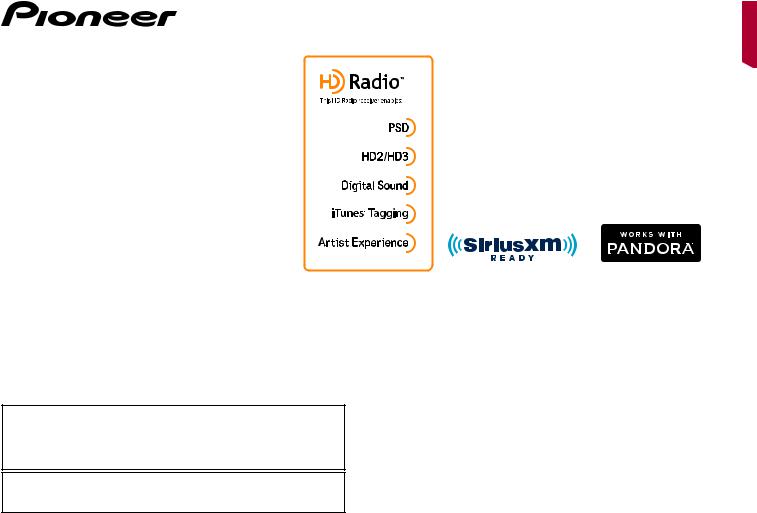
AVIC-8200NEX
AVIC-7200NEX
AVIC-6200NEX
AVIC-5200NEX
MULTIMEDIA NAVIGATION RECEIVER
Notice to all users:
This software requires that the product is properly connected to your vehicle’ s parking brake and depending on your vehicle, additional installation may be required. For more information, please contact your Authorized Pioneer Electronics retailer or call us at (800) 421-1404.
Be sure to read Important Information for the User first!
Important Information for the User includes the important information that you must understand before using this product.
English
Operation Manual

Contents
Thank you for buying this Pioneer product. Please read through these instructions so you will know how to operate your model properly. After you have finished reading the instructions, keep this document in a safe place for future reference.
 Important
Important
The screens shown in the examples may differ from actual screens, which may be changed without notice for performance and function improvements.
|
■Precaution.......................... |
4 |
|
Notes on internal memory................................ |
4 |
|
About this manual............................................. |
4 |
|
Use and care of the remote control................... |
4 |
|
■Basic operation.................. |
5 |
|
Checking part names and functions.................. |
5 |
|
Remote control................................................. |
5 |
|
Protecting your product against theft................ |
6 |
|
Notes on using the LCD panel.......................... |
6 |
|
Adjusting the LCD panel angle......................... |
6 |
|
Inserting/ejecting/connecting media................. |
6 |
|
On first-time startup.......................................... |
7 |
|
How to use the screens.................................... |
8 |
|
Supported AV source........................................ |
9 |
|
Displaying the AV operation screen.................. |
9 |
|
Selecting a source............................................ |
9 |
|
Changing the display order of sources.............. |
9 |
|
Using the touch panel....................................... |
9 |
|
■How to use the Navigation |
|
|
menu screen..................... |
10 |
|
Operating the Navigation menu screen........... |
11 |
|
■How to use the map.......... |
12 |
|
How to read the map screen........................... |
12 |
|
Operating the map screen.............................. |
12 |
|
Understanding the route guidance.................. |
13 |
|
Browsing the data field................................... |
14 |
|
■Searching for a |
|
2 |
destination........................ |
14 |
How to plan your route.................................... |
14 |
Searching for a location by address................ |
14 |
Searching for Points of Interest (POI)............. |
15 |
Selecting a destination from stored |
|
locations.................................................... |
16 |
Selecting a destination from stored routes...... |
16 |
Selecting a location you searched for |
|
recently...................................................... |
16 |
Searching for a location using “Combined |
|
Search”...................................................... |
16 |
Searching for a location by the coordinates.... |
17 |
Searching for a location by scrolling the |
|
map........................................................... |
17 |
Using the “Map Location” screen.................... |
17 |
■Checking and modifying |
|
the current route.............. |
18 |
Modifying the route......................................... |
18 |
■Registering and editing |
|
locations and routes........ |
20 |
Storing a location in “Saved Location”............. |
20 |
Storing a route in “Saved Routes”................... |
20 |
Editing the stored route................................... |
20 |
Deleting stored routes.................................... |
20 |
Saving a location as an alert point.................. |
21 |
■Receiving real-time traffic |
|
information (TMC)............ |
21 |
Displaying the “Traffic Summary” screen......... |
21 |
Viewing the traffic list...................................... |
21 |
Checking the traffic incidents on the map....... |
22 |
When traffic incidents occur on your route...... |
22 |
Turning the traffic information on or off............ |
22 |
■Checking useful |
|
information about your |
|
trip..................................... |
22 |
Displaying the “Useful Information” menu....... |
22 |
Recording your travel history.......................... |
23 |
Using the Trip Computer mode....................... |
23 |
Calculating the fuel consumption.................... |
23 |
■Customizing preferences of |
|
the navigation................... |
24 |
Customizing the navigation settings............... |
24 |
Information on each option of “Settings”......... |
25 |
Setting the alert point warnings...................... |
28 |
Getting the map update.................................. |
29 |
Expanding the use of the navigation |
|
functions.................................................... |
29 |
Compatibility and connectivity........................ |
29 |
■Bluetooth® connection..... |
30 |
Displaying the “Bluetooth” screen................... |
30 |
Registering your Bluetooth devices................ |
30 |
Connecting a registered Bluetooth device |
|
manually.................................................... |
31 |
Switching visibility........................................... |
31 |
Entering the PIN code for Bluetooth wireless |
|
connection................................................. |
31 |
Displaying the device information................... |
31 |
Clearing the Bluetooth memory...................... |
31 |
Updating Bluetooth software........................... |
31 |
Displaying the Bluetooth software version...... |
31 |
■Hands-free phoning......... |
32 |
Displaying the phone menu screen................. |
32 |
Making a phone call........................................ |
32 |
Receiving a phone call.................................... |
32 |
Minimizing the dial confirmation screen.......... |
33 |
Changing the phone settings.......................... |
33 |
Using the voice recognition function............... |
33 |
Notes for hands-free phoning......................... |
33 |
■Setup for iPod / iPhone or |
|
smartphone...................... |
34 |
The basic flow of iPod / iPhone or smartphone |
|
setup......................................................... |
34 |
Setting the device connection method............ |
34 |
iPod / iPhone compatibility.............................. |
34 |
Android™ device compatibility......................... |
34 |
Information on the connections and functions |
|
for each device.......................................... |
35 |
■Radio................................. |
37 |
Starting procedure.......................................... |
37 |
Storing the strongest broadcast |
|
frequencies................................................ |
37 |
Displaying the “Radio settings” screen............ |
37 |
■HD Radio™......................... |
38 |
HD Radio stations........................................... |
38 |
Starting procedure.......................................... |
39 |
Storing the strongest broadcast |
|
frequencies................................................ |
39 |
Displaying the “Radio settings” screen............ |
39 |
■Disc................................... |
39 |
Starting procedure.......................................... |
41 |
Selecting files from the track name list............ |
41 |
Switching the media file type.......................... |
41 |
Searching for the part you want to play........... |
41 |
Operating the DVD menu................................ |
41 |
Switching the subtitle/audio language............. |
41 |
Operating the DVD menu using touch panel |
|
keys........................................................... |
42 |
■Compressed files............. |
42 |
Starting procedure (for Disc)........................... |
44 |
Starting procedure (for USB/SD).................... |
44 |
Operations common to all file types................ |
44 |
Audio file operations....................................... |
44 |
Video file operations....................................... |
45 |
Still image file operations................................ |
45 |
■iPod................................... |
45 |
Connecting your iPod..................................... |
46 |
Starting procedure.......................................... |
47 |
Selecting song or video sources from the |
|
playlist screen............................................ |
47 |
Using this product’s iPod function from your |
|
iPod........................................................... |
47 |
Selecting a song from the list related to the |
|
song currently playing (link search)........... |
47 |
Using Apple Music Radio................................ |
47 |
■AppRadio Mode................ |
48 |
AppRadio Mode Compatibility........................ |
48 |
Using AppRadio Mode.................................... |
48 |
Starting procedure.......................................... |
48 |
Using the keyboard (for iPhone users)............ |
49 |
Adjusting the image size (for smartphone |
|
(Android) users)......................................... |
49 |
Using the audio mix function........................... |
49 |
■Apple CarPlay................... |
50 |
Using Apple CarPlay....................................... |
50 |
Starting procedure.......................................... |
50 |
Setting the driving position............................. |
50 |
Adjusting the volume...................................... |
50 |
■Android Auto™.................. |
51 |
Using Android Auto......................................... |
51 |
Starting procedure.......................................... |
51 |
Setting the auto-launch function..................... |
51 |
Setting the driving position............................. |
51 |

Contents |
|
Adjusting the volume...................................... |
51 |
■Pandora®........................... |
52 |
Using Pandora................................................ |
53 |
Starting procedure.......................................... |
53 |
Selecting a Pandora station from the list......... |
53 |
Adding a station.............................................. |
53 |
■Bluetooth audio player.... |
54 |
Starting procedure.......................................... |
54 |
Selecting files from the file name list............... |
54 |
■SiriusXM® Satellite |
|
Radio................................. |
55 |
SiriusXM tuner operations.............................. |
55 |
Starting procedure.......................................... |
55 |
Subscribing to the SiriusXM Satellite Radio |
|
service....................................................... |
56 |
Selecting a channel from the category list...... |
56 |
Using TuneScan™........................................... |
56 |
Using TuneMix™.............................................. |
56 |
Displaying the “SiriusXM Settings” screen...... |
56 |
Setting TuneStart™.......................................... |
56 |
Setting parental lock....................................... |
56 |
Checking the update traffic and weather |
|
information................................................. |
57 |
Using SportsFlash™........................................ |
57 |
Using the content alerts function.................... |
57 |
Selecting teams for Game Alert...................... |
58 |
Using Featured Favorites Band...................... |
58 |
Restoring the “SiriusXM Settings” to the |
|
default........................................................ |
58 |
■HDMI source..................... |
58 |
Starting procedure.......................................... |
58 |
■AUX source....................... |
59 |
Starting procedure.......................................... |
59 |
Setting the video signal................................... |
59 |
■AV input............................ |
59 |
Starting procedure (for AV source)................. |
59 |
Starting procedure (for camera)...................... |
60 |
Setting the video signal................................... |
60 |
■MIXTRAX........................... |
60 |
Using MIXTRAX............................................. |
61 |
Starting procedure.......................................... |
61 |
Selecting an item from the list......................... |
61 |
Selecting songs not to be played.................... |
61 |
Displaying the “MIXTRAX Settings” screen..... |
61 |
■iDatalink............................ |
62 |
Using iDatalink............................................... |
62 |
Starting procedure.......................................... |
62 |
Using functions in Car Sources....................... |
62 |
Using functions in Car Features...................... |
62 |
Displaying the setting screen for iDatalink...... |
63 |
■System settings................ |
63 |
Displaying the “System” setting screen........... |
63 |
Setting the navigation information bar............ |
63 |
Setting navigation screen interruption............. |
63 |
Setting Bluetooth audio source activation....... |
63 |
Setting the ever scroll..................................... |
64 |
Setting the beep tone...................................... |
64 |
Setting the rear view camera.......................... |
64 |
Setting the second camera............................. |
65 |
Setting the camera for Camera View mode..... |
65 |
Setting the demo mode................................... |
65 |
Selecting the system language....................... |
65 |
Setting the keyboard language with the |
|
application for iPhone................................ |
65 |
Adjusting the response positions of the touch |
|
panel (touch panel calibration)................... |
65 |
Setting the dimmer......................................... |
66 |
Adjusting the picture....................................... |
66 |
Displaying the firmware version...................... |
66 |
Displaying the open source licenses............... |
67 |
Updating firmware.......................................... |
67 |
Checking sensor learning status and driving |
|
status......................................................... |
67 |
Checking the connections of leads................. |
67 |
■Audio adjustments........... |
68 |
Displaying the “Audio” setting screen.............. |
68 |
Using fader/balance adjustment..................... |
68 |
Switching sound muting/attenuation............... |
68 |
Adjusting source levels................................... |
68 |
Setting the rear speaker output....................... |
68 |
Setting the subwoofer output.......................... |
68 |
Adjusting the cutoff frequency value............... |
68 |
Selecting the listening position....................... |
68 |
Adjusting the speaker output levels finely....... |
69 |
Adjusting the time alignment........................... |
69 |
Using the equalizer......................................... |
69 |
Adjusting the equalizer curve automatically |
|
(Auto EQ)................................................... |
69 |
■Theme menu..................... |
71 |
Displaying the “Theme” setting screen............ |
71 |
Selecting the wallpaper.................................. |
71 |
Setting the illumination color........................... |
71 |
Selecting the theme color............................... |
71 |
Selecting the style of the clock........................ |
71 |
Changing the preinstalled splash screen........ |
71 |
Replicating the settings.................................. |
72 |
■Video settings................... |
72 |
Setting up the video player............................. |
72 |
Setting the video signal for the rear view |
|
camera...................................................... |
73 |
■Favorite menu................... |
74 |
Creating a shortcut......................................... |
74 |
Selecting a shortcut........................................ |
74 |
Removing a shortcut....................................... |
74 |
■Other functions................ |
74 |
Setting the time and date................................ |
74 |
Setting the “Sound Retriever” function............ |
74 |
Changing the wide screen mode.................... |
74 |
Storing song information to an iPod (iTunes® |
|
Tagging)..................................................... |
74 |
Selecting the video for the rear display........... |
75 |
Setting the anti-theft function.......................... |
75 |
Restoring this product to the default |
|
settings...................................................... |
76 |
■Appendix........................... |
76 |
Troubleshooting.............................................. |
76 |
Error messages.............................................. |
77 |
Positioning technology.................................... |
80 |
Handling large errors...................................... |
81 |
Route setting information................................ |
84 |
Handling and care of discs............................. |
84 |
Playable discs................................................. |
84 |
Detailed information for playable media.......... |
85 |
Bluetooth........................................................ |
87 |
SiriusXM® satellite radio................................. |
87 |
HD Radio™ Technology................................... |
88 |
SDHC............................................................. |
88 |
WMA/WMV..................................................... |
88 |
FLAC.............................................................. |
88 |
DivX................................................................ |
88 |
AAC................................................................ |
88 |
Google, Google Play, Android™....................... |
88 |
Android Auto................................................... |
88 |
MIXTRAX....................................................... |
88 |
Detailed information regarding connected iPod |
|
devices...................................................... |
88 |
Using app-based connected content.............. |
89 |
Pandora®........................................................ |
89 |
HDMI.............................................................. |
89 |
MHL................................................................ |
89 |
IVONA Text-to-Speech.................................... |
89 |
Notice regarding video viewing....................... |
90 |
Notice regarding DVD-Video viewing.............. |
90 |
Notice regarding MP3 file usage..................... |
90 |
Notice regarding open source licenses........... |
90 |
Map coverage................................................. |
90 |
Using the LCD screen correctly...................... |
90 |
Specifications................................................. |
90 |
3

 Precaution
Precaution
Notes on internal memory
Before removing the vehicle battery
If the battery is disconnected or discharged, the memory will be erased and must be reprogrammed.
Some of the settings and recorded contents will not be reset.
Data subject to erasure
The information is erased by disconnecting the yellow lead from the battery (or removing the battery itself).
Some of the settings and recorded contents will not be reset.
Resetting the microprocessor
 CAUTION
CAUTION
Pressing the RESET button resets settings and recorded contents to the factory settings.
—Do not perform this operation when a device is connected to this product.
—Some of the settings and recorded contents will not be reset.
The microprocessor must be reset under the following conditions:
Prior to using this product for the first time after installation.
If this product fails to operate properly.
If there appears to be problems with the operation of the system.
If your vehicle position is shown on the map with a significant positioning error.
1Turn the ignition switch OFF.
2Press the RESET button with a pen tip or other
pointed implement.
Refer to Checking part names and functions on page 5 Settings and recorded contents are reset to the factory settings.
About this manual
This manual uses diagrams of actual screens to describe operations. However, the screens on some products may not match those shown in this manual depending on the model used.
4
Meanings of Symbols Used in This
Manual
X0000BT |
This indicates model name that are supported |
|
the described operations. |
||
|
||
|
This indicates to touch an appropriate soft key |
|
|
on the touch screen. |
|
|
|
|
HOLD |
This indicates to touch and hold an appropri- |
|
ate soft key on the touch screen. |
||
|
|
|
|
This indicates that there is a reference or |
|
|
supplementary for the key or screen. |
|
|
|
Use and care of the remote control
Installing the battery
Slide the tray on the back of the remote control out and insert the battery with the plus (+) and minus (–) poles aligned properly.
When using for the first time, pull out the film protruding from the tray.
 WARNING
WARNING
Do not ingest the battery, Chemical Burn Hazard.
This product, including the supplied remote control, contains a coin/button cell battery. If the coin/button cell battery is swallowed, it can cause severe internal burns in just two hours and can lead to death.
Keep new or used batteries out of the reach of children. If the battery is swallowed or placed inside any part of the body, consult a doctor immediately.
If the battery compartment does not close securely, stop using the product and keep it away from children.
Batteries (battery pack or batteries installed) must not be exposed to excessive heat such as sunshine, fire or the like.
 CAUTION
CAUTION
Remove the battery if the remote control is not used for a month or longer.
There is a danger of explosion if the battery is incorrectly replaced. Replace only with the same or equivalent type.
Do not handle the battery with metallic tools.
Do not store the battery with metallic objects.
If the battery leaks, wipe the remote control completely clean and install a new battery.
When disposing of used batteries, comply with governmental regulations or environmental public institutions’ rules that apply in your country/area.
“Perchlorate Material – special handling may apply. See www.dtsc.ca.gov/hazardouswaste/perchlorate. (Applicable to California, U.S.A.)”
Using the remote control
Point the remote control in the direction of the front panel to operate.
pThe remote control may not function properly in direct sunlight.
 CAUTION
CAUTION
Do not store the remote control in high temperatures or direct sunlight.
Do not let the remote control fall onto the floor, where it may become jammed under the brake or gas pedal.
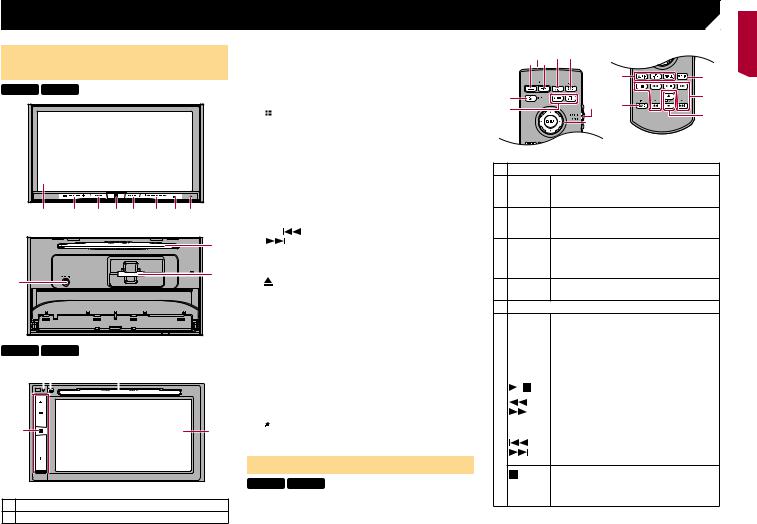
 Basic operation
Basic operation
Checking part names and functions
8200NEX 7200NEX
1 |
2 |
3 4 5 |
6 7 8 |
9
a
b
6200NEX |
5200NEX |
|
|
||
8 |
|
7 |
9 |
||
|
|
|
|
|
|
|
|
|
|
|
|
|
|
|
|
|
|
2

3

4 |
1 |
5

6


c 
 d
d 
1LCD screen
2VOL (+/–) button
3 |
MAP |
|
Press to display the map screen. |
|
|
button |
Press and hold to switch to the camera view |
||
|
|
|
mode. |
|
|
|
|
p |
This function is available only when “ Back |
|
|
|
|
Camera Input” or “2nd Camera Input” is |
|
|
|
|
set to “On”. |
4 |
button |
Press to display the top menu screen. |
||
|
Press and hold to activate the voice recogni- |
|||
|
|
|
||
|
|
|
tion function. |
|
|
|
|
|
Refer to Using the voice recognition func- |
|
|
|
|
tion on page 33 |
5 |
MODE |
Press to switch between the Application |
||
|
button |
screen and the AV operation screen. |
||
|
|
|
Press to turn the display off. |
|
|
|
|
p |
Press and hold to turn the display off when |
|
|
|
|
the Application screen is available. |
|
|
|
p |
When the display is turned off, touch the |
|
|
|
|
screen to revert to the original screen. |
6 |
TRK ( |
|
Press to return to the previous track (chapter) |
|
|
|
or go to the next track (chapter). |
||
|
/ |
) |
||
|
Press and hold to perform fast reverse or fast |
|||
|
button |
|||
|
forward. |
|||
|
|
|
||
|
|
|
Press to answer or end a call. |
|
7 |
button |
|
|
|
|
|
|
||
8 |
RESET |
|
Refer to Resetting the microprocessor on |
|
|
button |
|
page 4 |
|
9 |
Disc- |
|
|
Refer to Inserting and ejecting a disc on |
|
loading |
|
page 6 |
|
|
slot |
|
|
|
10 |
SD card |
|
Refer to Inserting and ejecting an SD |
|
|
slot |
|
|
memory card on page 7 |
11 |
Auto EQ |
Use to connect a microphone for acoustical |
||
|
micro- |
measurement (sold separately). |
||
|
phone |
|
|
|
|
input jack |
|
|
|
12 |
Detachable faceplate |
|||
13 |
button |
Press to remove the detachable faceplate from |
||
|
this product. |
|||
|
|
|
||
Remote control
8200NEX 6200NEX
1 |
2 3 |
|
|
|
|
|
b |
8 |
|
6 |
4 |
c |
9 |
|
7 |
a |
|||
|
|
|||
|
5 |
|
||
|
|
|
1Volume (+/–)
2REAR SRC Press to cycle through all the available rear
sources.
Press and hold to turn the rear source off.
3 SRC/OFF Press to cycle through all the available front sources.
Press and hold to turn the front source off.
4Source Use to switch the source mode between the mode front source and the rear source.
select switch
5Thumb Use to select a menu on the DVD menu. pad
6MUTE
7MENU Press to display the DVD menu during DVD
|
|
playback. |
|
TOP |
Press to return to the top menu during DVD |
|
MENU |
playback. |
8 RETURN |
Press to return to the specified point and start |
|
|
|
playback from there. |
9 |
|
Press to pause or resume playback. |
|
|
|
|
or |
For audio: Press and hold to perform fast |
|
reverse or fast forward. |
|
|
|
|
|
|
For video: Press to perform fast reverse or fast |
|
|
forward. |
|
or |
Press to return to the previous track (chapter) |
|
or go to the next track (chapter). |
|
|
|
|
|
|
Press to answer or end a call. |
Press to stop playback.
pIf you resume playback, playback will start from the point where you stopped. Touch the key again to stop playback completely.
5
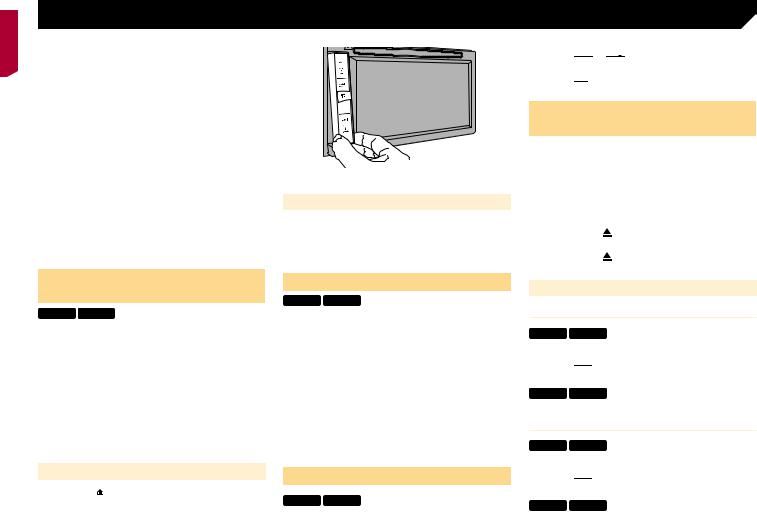
 Basic operation
Basic operation
10 |
FOLDER/P. |
Press to select the next or previous title or |
|
CH |
folder. |
|
|
Press to recall radio station frequencies |
|
|
assigned to preset channel keys. |
|
|
Press to answer or end a call. |
11 |
AUDIO |
Press to change the audio language during |
|
|
DVD playback. |
|
SUBTITLE |
Press to change the subtitle language during |
|
|
DVD playback. |
|
ANGLE |
Press to change the viewing angle during DVD |
|
|
playback. |
12 |
BAND/ |
Press to select the tuner band when tuner is |
|
ESC |
selected as a source. |
|
|
Press to switch between media file types when |
|
|
playing the following types of data: |
|
|
Disc |
|
|
External storage device (USB, SD) |
p7200NEX/5200NEX
The remote control CD-R33 (sold separately) is available.
For details, refer to the remote control manual.
Protecting your product against theft
6200NEX 5200NEX
1 

1 Detachable faceplate
Attaching the detachable faceplate
1Slide the detachable faceplate all the way into this product.
2Push the lower part of the detachable faceplate until you hear a click.
Notes on using the LCD panel
8200NEX 7200NEX
 WARNING
WARNING
2Touch 



 or
or 




 to adjust the angle of the LCD panel.
to adjust the angle of the LCD panel.
3Touch 

 .
.
Returns to the previous screen.
Inserting/ejecting/connecting media
 CAUTION
CAUTION
Do not insert anything other than a disc into the discloading slot.
Do not insert anything other than SD memory cards into the SD card slot.
Ejecting an SD memory card during data transfer can damage the SD memory card. Be sure to eject the SD memory card by the procedure described in this manual.
Do not press the |
button when an SD memory card is not |
fully inserted. Doing so may damage the card. |
|
Do not press the |
button before an SD memory card has |
been completely removed. Doing so may damage the card.
Inserting and ejecting a disc
Inserting a disc
 CAUTION
CAUTION
Do not expose the detachable faceplate to excessive shock or disassemble it.
Never grip the buttons tightly or use force when removing or attaching the detachable faceplate.
Keep the detachable faceplate out of reach of small children to prevent them from placing it in their mouths.
After removing the detachable faceplate, keep it in a safe place so it is not scratched or damaged.
Do not expose the detachable faceplate to direct sunlight and high temperatures.
When removing or attaching the detachable faceplate, do so after turning off the ignition switch (ACC OFF).
Removing the detachable faceplate
1 |
Press the button. |
2 |
Gently grip the bottom of the detachable face- |
6 |
plate and slowly pull it outward. |
|
Keep hands and fingers clear of this product when opening, closing, or adjusting the LCD panel. Be especially cautious of children’s hands and fingers.
Do not use with the LCD panel left open. It may result in injury in the event of an accident.
 CAUTION
CAUTION
Do not open or close the LCD panel by force. It may cause a malfunction.
Do not operate this product until the LCD panel has completely opened or closed. If this product is operated while the LCD panel is opening or closing, the LCD panel may stop at that angle for safety.
Do not place a glass or can on the open LCD panel.
Adjusting the LCD panel angle
8200NEX 7200NEX
1 Press the button.
button.
8200NEX 7200NEX
1Press the button.
button.
2Touch 


 to open the LCD panel.
to open the LCD panel.
3Insert a disc into the disc-loading slot.
6200NEX 5200NEX
1 Insert a disc into the disc-loading slot.
Ejecting a disc
8200NEX 7200NEX
1Press the button.
button.
2Touch 


 to open the LCD panel.
to open the LCD panel.
3Remove the disc, and press the button.
button.
6200NEX 5200NEX
1 Press the button.
button.
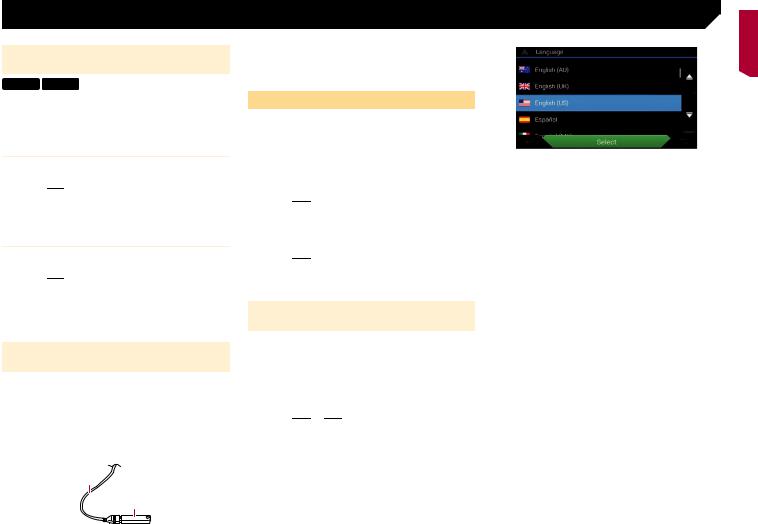
 Basic operation
Basic operation
Inserting and ejecting an SD memory card
8200NEX 7200NEX
pThis system is not compatible with the Multi Media Card (MMC).
pCompatibility with all SD memory cards is not guaranteed.
pThis product may not achieve optimum performance with some SD memory cards.
Inserting an SD memory card
1Press the button.
button.
2Touch 

 to open the LCD panel.
to open the LCD panel.
3Insert an SD memory card into the SD card slot.
4Press the button.
button.
Ejecting an SD memory card
1Press the button.
button.
2Touch 

 to open the LCD panel.
to open the LCD panel.
3Press the middle of the SD memory card gently until it clicks.
4Pull the SD memory card out straight.
5Press the button.
button.
Plugging and unplugging a USB storage device
pThis product may not achieve optimum performance with some USB storage devices.
pConnection via a USB hub is not possible.
pA USB cable is required for connection.
1Pull out the plug from the USB port of the USB cable.
2Plug a USB storage device into the USB cable.
1
2
1USB cable
2USB storage device
pCheck that no data is being accessed before pulling out the USB storage device.
On first-time startup
1Start the engine to boot up the system.
The “Select Program Language” screen appears.
p From the second time on, the screen shown will differ depending on the previous conditions.
p From the second time on, enter the password for the antitheft function if the password entry screen appears.
2Touch the language.
3Touch 

 .
.
The “Smartphone Setup” screen appears.
4 Touch the item.
Refer to Information on the connections and functions for each device on page 35
5 Touch 

 .
.
The warning message screen appears.
6 Touch [OK].
The top menu screen appears.
On first-time startup of the navigation system
When you use the navigation function for the first time, an initial setup process starts automatically. Follow the steps below.
pYou can change the language later using [Regional] in the “Settings” screen. Other settings can be restarted later using [Start Configuration Wizard] in the “Settings” screen.
1Press the 
 button.
button.
2Touch  or
or 




 .
.
3Touch the language that you want to use on the navigation screen, then touch [Select].
4Read the terms carefully, checking the details, and then touch [Accept] if you agree to the conditions.
5Touch [Next].
6Touch the language that you want to use for voice guidance messages, then touch [Next].
7If needed, modify the unit settings, then touch [Next].
8If needed, modify the default route planning options, then touch [Next].
9Touch [Activate], then [Next].
A message saying that the connected online features are activated appears if you activate these services right away.
Refer to “Connected Services” settings on page 28
10 Touch the connected services you want to use, then touch [Next].
The initial setup is now complete. The map screen appears and you can start using the navigation system.
7
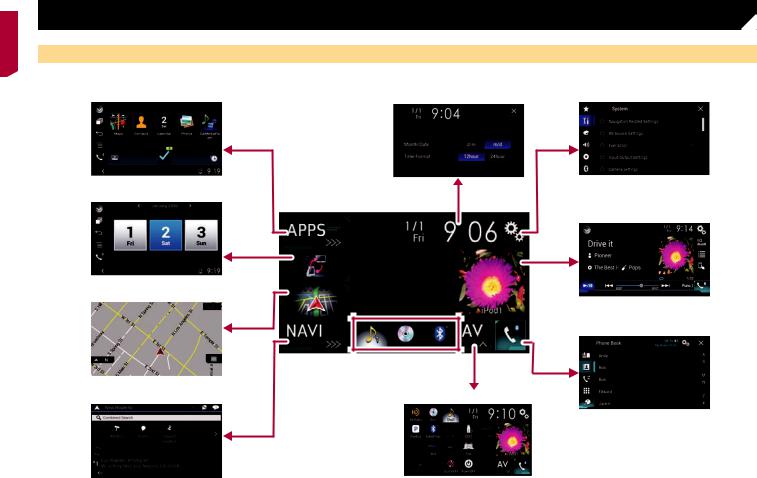
 Basic operation
Basic operation
How to use the screens
Application menu screen |
Time and date setting screen |
Setting menu screen |
Application operation screen
Top menu screen
AV operation screen
Map screen
Phone menu screen
Favorite source icons
Navigation menu screen |
AV source selection screen |
8
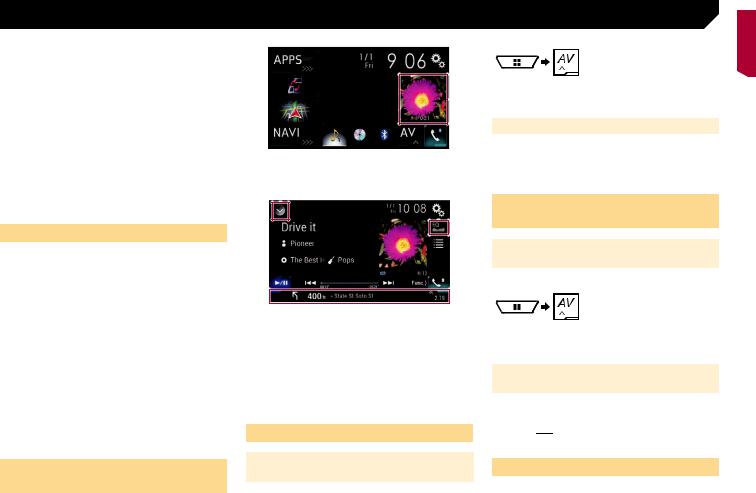
 Basic operation
Basic operation
pBy pressing the 
 button on any screen you can display the top menu screen.
button on any screen you can display the top menu screen.
pThe character string “APPS” is replaced with “Apple CarPlay” when Apple CarPlay is running.
p8200NEX/7200NEX
The character string “APPS” is replaced with “Android Auto” when Android Auto is running.
pIf you select “Power OFF” on the AV source selection screen, you can turn off almost all functions. The “Power OFF” mode is released in the following cases:
—An incoming call is received.
—The rear view camera image is input when the vehicle reverses.
—A button on this product is pressed.
—The ignition switch is turned off (ACC OFF), then turned on (ACC ON).
pTo protect this product from damage, the cooling fan may operate in “Power OFF” mode.
Supported AV source
You can play or use the following sources with this product.
Radio (FM, AM) (*1)
HD Radio (HD Radio™ tuner) (*2)
CD
ROM (compressed audio or video files on discs)
DVD-Video
Video-CD
The following sources can be played back or used by connecting an auxiliary device.
USB
SD (*3)
iPod
Pandora®
Bluetooth® audio
SiriusXM® Satellite Radio
AV input (AV)
AUX
HDMI (*2)
Car Sources (iDataLink) p (*1) 5200NEX
p(*2) 8200NEX/7200NEX/6200NEX
p(*3) 8200NEX/7200NEX
Displaying the AV operation screen
1 Press the 
 button.
button.
1
1 AV operation key
The AV operation screen appears.
1 2
3
1Displays the source list.
2Recalls equalizer curves.
Refer to Using the equalizer on page 69
3Shows the navigation information. p This is not displayed for some sources.
p This is not displayed when “Navigation info window” is set to “Off”.
Refer to Setting the navigation information bar on page 63
Selecting a source
Source on the AV source selection screen
1 Display the AV source selection screen.
2 Touch the source icon.
p When you select “Source OFF”, the AV source is turned off.
Source on the source list
1 Display the source list.
Refer to Displaying the AV operation screen on page 9
2 Touch the source key.
p When you select “Source OFF”, the AV source is turned off.
Changing the display order of sources
Changing the display order of source icons
1Display the AV source selection screen.
2Touch and hold a source icon, and drag the icon to the desired position.
Changing the display order of source keys
1 Display the source list.
Refer to Displaying the AV operation screen on page 9
2Touch 


 .
.
3Drag the source key to the desired position.
Using the touch panel
You can operate this product by touching the keys on the screen directly with your fingers.
pTo protect the LCD screen from damage, be sure to touch the screen only with your finger gently.
2 Touch the AV operation key. |
9 |
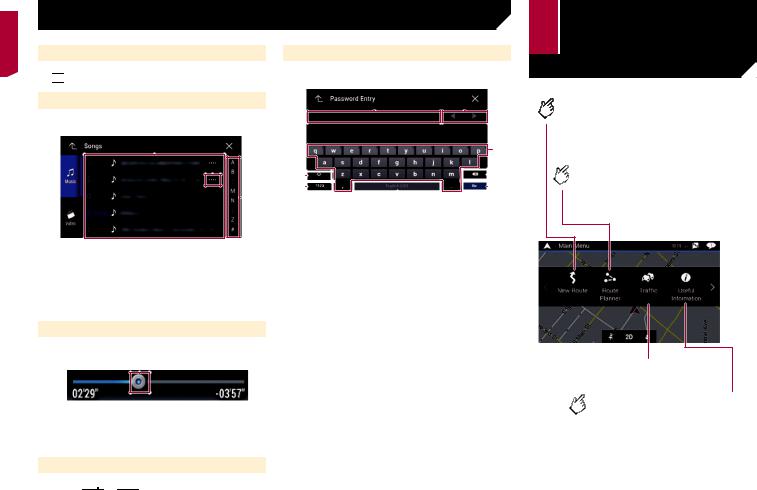
 Basic operation
Basic operation
Common touch panel keys


 : Returns to the previous screen.
: Returns to the previous screen.


 : Closes the screen.
: Closes the screen.
Operating list screens
1 2
3
1Touching an item on the list allows you to narrow down the options and proceed to the next operation.
2Appears when all characters are not displayed on the display area.
If you touch the key, the rest are scrolled for display.
3Appears when items cannot be displayed on a single page. Drag the slider bar or the list to view any hidden items.
Operating the on-screen keyboard
1 2
|
|
|
3 |
|||||||
8 |
|
|
|
|
|
|
4 |
|||
7 |
|
|
|
|
|
5 |
||||
|
|
|
6 |
|
|
|
|
|
||
1Displays the characters that are entered.
2Moves the cursor to the right or left for a number of characters equivalent to the number of touches.
3Enters the characters in the text box.
4Deletes the input text to the left of the cursor one letter at a time. Touching and holding the key deletes the letters to the left of the cursor in rapid succession.
5Confirms the entry and proceeds to the next step.
6Enters a space.
7Switches between alphabet and numbers/symbols.
8Switches between capital and lower case letters.
Operating the time bar
1
1 You can change the playback point by dragging the key.
pPlayback time corresponding to the position of the key is displayed while dragging the key.
pThis function is not available for some media or sources.
Switching the operation panel
1 Touch  or
or 



 .
.
The hidden function keys appears.
p This key does not appear for some AV sources.
How to use the Navigation menu  screen
screen
Searches for your destination by the address or coordinates, or searches for the selected place of interest, etc.
Builds your route or edits the route currently set.
Main Menu 1
(without a planned route)
 Displays the traffic screen.
Displays the traffic screen.
Displays useful information to support your driving.
10
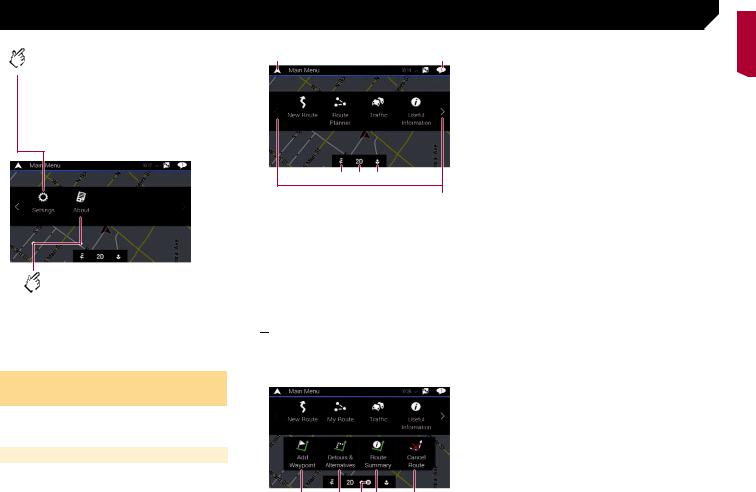
 How to use the Navigation menu screen
How to use the Navigation menu screen
Configures the navigation-related settings.
You can also access the “SyncTool” screen from this menu.
Main Menu 2
(without a planned route)
Displays information about your navigation system.
The version information, or licenses can be displayed, for example.
p5200NEX
The traffic features of [Traffic] can be used when the online traffic feature is available.
Operating the Navigation menu screen
1Press the MAP button.
2Touch  .
.
Other items
You will also see the following keys when you are navigating without a planned route.
1 |
2 |
3 4 5
6
1Returns to the map screen.
2Displays notifications that contain important information.
3Displays the location that you saved as a favorite.
4Switches among 2D, 3D, and 2D North up view modes.
5Displays the “User Profiles” screen where you can create new profiles or edit the existing profiles.
If multiple drivers are using this product, they can create their own profiles with their own settings. If you select a new profile, this product restarts so that the new settings can take effect.
6Displays the previous or next page of the navigation menu. If there is no next or previous page, this item is grayed out.
p

 on the upper right corner of the screen is used for
on the upper right corner of the screen is used for
AVICSYNC App connection.
Be sure read Expanding the use of the navigation functions
(page 29) before using the AVICSYNC function.
When you are navigating a planned route, the following routerelated keys are available.
2Displays route alternatives, parts of the route to avoid, or specific roads in your planned route to avoid.
3Suspends and resumes the route guidance.
4Displays the route in its full length on the map, and displays route parameters and route alternatives.
5Deletes your route or removes a waypoint.
1 |
2 |
3 4 |
5 |
1 Adds a waypoint. |
11 |
|
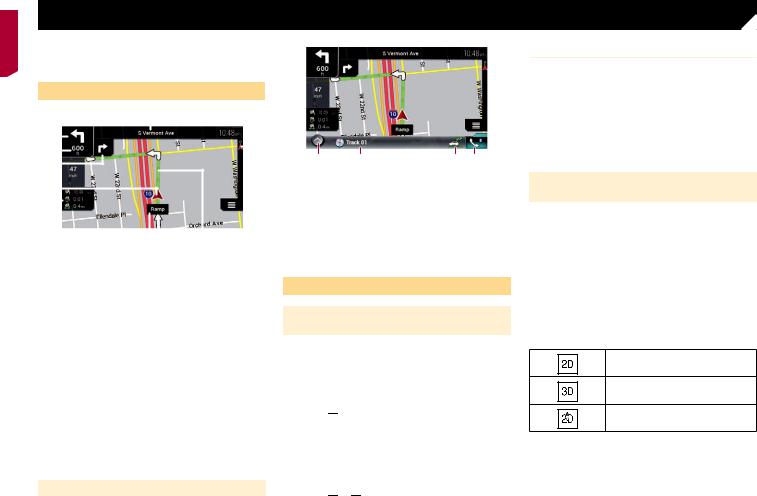
 How to use the map
How to use the map
Most of the information provided by your navigation system can be seen on the map. You need to become familiar with how information appears on the map.
How to read the map screen
|
|
1 |
|
|
|
|
|||||
2 |
|
|
|
|
|
|
|
|
|
|
9 |
|
|
|
|
|
|
|
|
|
|
||
|
|
|
|
|
|
|
|
|
|
||
|
|
|
|
|
|
|
|
|
|
||
3 |
|
|
|
|
|
|
|
|
|||
|
|
||||||||||
|
|
|
|
|
|
|
|
|
|
|
|
4 |
|
|
|
|
|
|
|
|
|
|
|
|
|
|
|
|
|
|
|
|
|
|
|
5 |
|
|
|
|
|
|
|
|
|
|
|
|
|
|
|
|
|
|
|
|
|
|
|
|
|
|
|
|
|
|
|
|
|
||
6 |
|
|
|
|
|
|
|
|
|
|
|
|
|
|
|
|
|
|
|
|
|
|
|
|
|
|
|
|
|
|
|
|
|
|
|
|
|
|
|
|
|
|
|
|
|
|
|
7 8
pThe following information marked with an asterisk (*) appears only when a route is set.
pDepending on the conditions and settings, some items may not be displayed.
1Shows the number and name of the street to be used (or next guidance point).*
2Shows the next guidance point (maneuver).*
The type of the event (turn, traffic circle, exiting freeway, etc.) is displayed.
Refer to Frequently shown route events on page 13
3Shows the distance to the next guidance point (maneuver).*
4Shows the maneuver after the next maneuver.*
5Indicates the current location of your vehicle. The apex of the triangular mark indicates your orientation and the display
moves automatically as you drive.
pWhen there is no GPS position, the triangular mark is transparent. It shows your last known position.
6Displays the data field.
7Shows the name of the street (or city) that your vehicle is traveling on (or in).
8Indicates the current route.*
The route currently set is highlighted in color on the map.
9Indicates the progress to the final destination.*
AV information bar
AV information is displayed at the bottom of the map screen.
1 |
2 |
3 4 |
1Touch to display the AV source list.
2Shows the current status of AV source briefly.
3You can turn on or off the communication between the AVICSYNC App and the navigation system by touching the
key.
pThis setting is always turned on when you use the AVICSYNC App on an iPod / iPhone (the setting cannot
be changed).
4Touch to display the phone menu screen.
Refer to Displaying the phone menu screen on page 32
Operating the map screen
Changing the scale of the map manually
By default, even if the map scale is changed on the scrolled map, it will return to the preset scale (according to the setting in “Viewpoint”of the “Navigation Map” settings) when the current position map is displayed. If you change the scale of the current position map, perform the following procedure.
1Press the MAP button and touch  .
.
2Touch 

 , and then touch [Settings].
, and then touch [Settings].
3Touch [Navigation Map], and then [Map Display].
4Touch [Viewpoint].
5Drag the pop-up window and touch [Manual].
6Press the MAP button.
7Touch 

 or
or 

 .
.
Smart Zoom
Your navigation system features “Smart Zoom” that works in two ways:
When the route is set:
When approaching a turn, “Smart Zoom” will zoom in and raise the view angle to enable you to easily recognize your maneuver at the next junction. If the next turn is at a distance, it will zoom out and lower the view angle to be flat so you can see the road in front of you.
When the route is not set:
“Smart Zoom” will zoom in if you drive slowly and zoom out when you drive at high speed.
Switching between 2D, 3D, and 2D North up views
You can switch how the map is displayed. For 2D map view mode, you can select between “Heading up” and “North up”.
Heading up:
The map display always shows the vehicle’s direction as proceeding toward the top of the screen.
North up:
The map display always has north at the top of the screen.
pThe map orientation is fixed at “Heading up” when the 3D map screen is displayed.
1Press the MAP button.
2Touch  .
.
3Touch the following key.
Each time you touch the key the setting changes.
Indicates 2D Heading up view mode is currently selected.
Indicates 3D Heading up view mode is currently selected.
Indicates 2D North up view mode is currently selected.
pThere is a limit to map scaling in 3D map view mode. If the map scale is zoomed out further, the map is zoomed out in 2D map.
12
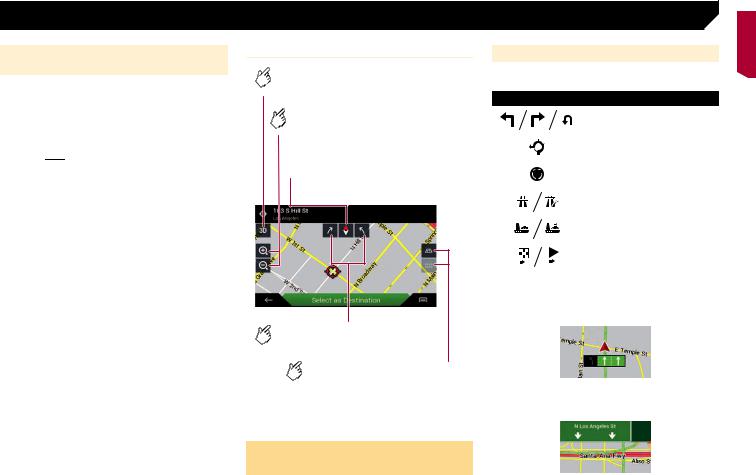
 How to use the map
How to use the map
Scrolling the map to the position you want to see
1Press the MAP button.
2Touch anywhere on the map or touch and drag
the map in the desired direction to scroll.
If you place the cursor on the desired location, a brief overview about the location will appear at the top of the screen, showing the street name and other information for the location.
3 Touch  .
.
The map returns to the current position.
pIf you press the MAP button, the map returns to the current position.
Control keys on the scrolled map
Changes the map view mode.
The current map mode is shown on the control key.
Zooms in or out on the map.
You can also zoom out or in by pinching or expanding the map.
 Cancels map rotation.
Cancels map rotation.
Map screen (scrolled map)
Rotates the map clockwise or counterclockwise.
Tilts the map angle up or down.
You can change the vertical view angle of the map in 3D mode only.
Frequently shown route events
The following are some examples of the maneuvers that are displayed.
Icon |
|
|
|
|
|
|
|
|
|
Meaning |
||
|
|
|
|
|
|
|
|
|
|
|
|
Turn left, turn right, turn back. |
|
|
|
|
|
|
|
|
|
|
|
|
|
|
|
|
|
|
|
|
|
|
|
|
|
|
|
|
|
|
|
|
|
|
|
|
|
|
|
|
|
|
|
|
|
|
|
|
|
|
|
Go left on the traffic circle, 3rd exit |
|
|
|
|
|
|
|
|
|
|
|
|
|
|
|
|
|
3 |
|
|
|
|
|
|
|
(next maneuver). |
|
|
|
|
|
|
|
|
|
|
|
|
|
|
|
|
|
|
|
|
|
|
|
|
|
|
|
|
|
|
|
|
|
|
|
|
|
|
Enter traffic circle (maneuver after |
|
|
|
|
|
|
|
|
|
|
|
|
|
|
|
|
|
|
|
|
|
|
|
|
|
the next maneuver). |
|
|
|
|
|
|
|
|
|
|
|
|
|
|
|
|
|
|
|
|
|
|
|
|
|
|
|
|
|
|
|
|
|
|
|
|
|
|
Freeway entrance or freeway exit. |
|
|
|
|
|
|
|
|
|
|
|
|
|
|
|
|
|
|
|
|
|
|
|
|
|
|
|
|
|
|
|
|
|
|
|
|
|
|
|
|
|
|
|
|
|
|
|
|
|
|
|
Board ferry or leave ferry. |
|
|
|
|
|
|
|
|
|
|
|
|
|
|
|
|
|
|
|
|
|
|
|
|
|
|
|
|
|
|
|
|
|
|
|
|
|
|
|
|
|
|
|
|
|
|
|
|
|
|
|
Approaching the destination or a |
|
|
|
|
|
|
|
|
|
|
|
|
|
|
|
|
|
|
|
|
|
|
|
|
|
waypoint. |
|
|
|
|
|
|
|
|
|
|
|
|
|
|
|
|
|
|
|
|
|
|
|
|
|
|
Lane information
When navigating on multilane roads, you will need to make sure to take the proper lane for the recommended route.
Signposts
Signs are displayed at the top of the map.
Understanding the route guidance
Once the route guidance begins, the system provides various guides by voice, text indications and signs.
Junction view
If you are approaching a complex intersection, the map is replaced with a 3D view of the junction.
13

 How to use the map
How to use the map
pIf the data for these items is not contained in the map data, the information is not available even if there are signs on the
actual road.
When you set “Offer Freeway Services” to “on”, the 


 icon appears while you are driving on freeways. Touch the icon to open the details of the next few exits or service stations. In addition, touch an item to show its location on the map. You can set it as a waypoint easily.
icon appears while you are driving on freeways. Touch the icon to open the details of the next few exits or service stations. In addition, touch an item to show its location on the map. You can set it as a waypoint easily.
pTouching and holding the field allows you to display the setting screen for the field.
Refer to Data Fields on page 27
pThe estimated time of arrival is an ideal value calculated based on the speed limit value set in “Max. Speed” of vehicle type setting and the actual driving speed. The estimated time of arrival is only a reference value, and does not guarantee arrival at that time.
Refer to “Route Preferences” settings on page 25
Browsing the data field
The data fields are different when you are navigating a route and when you have no specified destination. For example, the data field provides the following information.
When the route is set:
Distance to final destination, time needed to reach the final destination and estimated arrival time are shown.
When the route is not set: Direction or altitude is shown.
Searching for a  destination
destination
 CAUTION
CAUTION
For safety reasons, these route-setting functions are not available while your vehicle is in motion. To enable these functions, you must stop in a safe place and put on the parking brake.
pSome information regarding traffic regulations depends on the time when the route calculation is performed. Thus, the information may not correspond with a certain traffic regulation when your vehicle actually passes through the location in question. Also, the information on the traffic regulations provided applies for a passenger vehicle, and not for a truck or other delivery vehicles. Always follow the actual traffic regulations when driving.
p[Destination from Phone] and [Online Search] on the “New Route to...” screen can be used when the AVICSYNC App connection is established.
Be sure read Expanding the use of the navigation functions
(page 29) before using the AVICSYNC function.
How to plan your route
The following is a summary of the route setting procedure.
1 Search for a destination using various methods on the [New Route] menu.
The location you searched for appears on the “Map Location” screen.
2 Touch [Select as Destination].
Refer to Using the “Map Location” screen on page 17
The “Route Summary” screen appears and countdown begins. When the countdown ends, the guidance automatically starts. If you touch the screen anywhere during the countdown, the countdown stops and the screen will stay as it is.
Refer to Checking route information and preferences on page 19
3 Touch [Start Navigation].
Your navigation system starts the route guidance.
Refer to Understanding the route guidance on page 13
Searching for a location by address
The most frequently used function is the address search in which the address is specified and the location is searched.
14
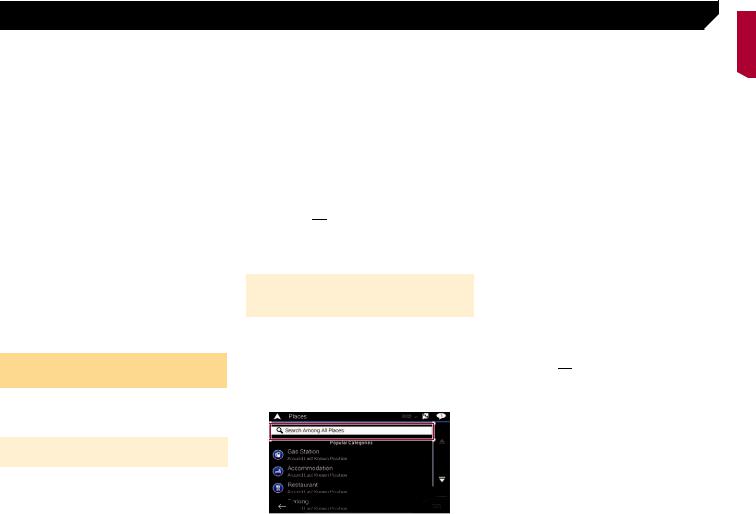
 Searching for a destination
Searching for a destination
pDepending on the search results, some steps may be skipped.
1Press the MAP button and touch  .
.
2Touch [New Route].
3Touch [Address].
4Touch the following text box and set the desti-
nation you are looking for.
Country:
By default, your navigation system proposes the country where you are.
If you want to change the area to search set another country.
City or ZIP code:
By default, your navigation system proposes the city/town where you are. You can select the city/town using its postal code instead of its name.
Street:
If the street name is not available, touch [Go to City] and select the city/town. This way the center of the selected city/ town becomes the destination of the route.
Select House Number or Intersection:
This item will be displayed after you have set a street. If the house number is not available, touch [Go to Street] and select the street. This way the center of the selected street becomes the destination of the route.
After you touch the selected address to finish the address search, the searched location appears on the map screen.
5 Touch [Select as Destination], and then touch [Start Navigation].
Your navigation system starts the route guidance.
Searching for Points of Interest (POI)
Information about various facilities (Points Of Interest – POI), such as gas stations, parking lots or restaurants, is available. You can search for a POI by selecting the category (or entering the POI Name).
Searching for POIs using preset categories
The preset search allows you to quickly find the most frequently selected types of POIs.
1Press the MAP button and touch  .
.
2Touch [New Route].
3 Touch [Places].
The preset search categories are as follows.
Gas Station
Accommodation
Restaurant
Parking
pWhen a route is not set, POIs are searched for around the current position.
pWhen the current position is not available either (no GPS signal), POIs are searched for around the last known position.
pWhen a route is set, “Gas Station” and “Restaurant” are searched for along the route, and “Accommodation” and “Parking” are searched for around the destination.
4Touch the category.
5Touch the POI.
The searched location appears on the map screen.
If you touch 

 , you can sort the results or show the locations of all facilities on the map.
, you can sort the results or show the locations of all facilities on the map.
6 Touch [Select as Destination], and then touch [Start Navigation].
Your navigation system starts the route guidance.
Searching for POIs by categories or directly from the name of the facilities
You can search for POIs by their categories and subcategories. You can also search for POIs by their names in each of their categories.
1Press the MAP button and touch  .
.
2Touch [New Route].
3Touch [Places].
4Touch [Search Among All Places].
5 Touch [Around Here] and then select the area in which the POIs should be searched for.
Category View:
You can select whether or not POI categories are displayed.
Around Here:
Searches around the current position. Or, around the last known position if the current position is not available. (The results will be listed in order of the distance from this position.)
In a City:
Searches for a place within a selected city/town. (The results will be listed in order of the distance from the center of the selected city/town.)
Around Destination:
Searches for a place around the destination of the current route. (The results will be listed in order of the distance from
the destination.)
pThis key is active only when the route is set.
Along Route:
Searches along the current route, and not around a point already set. This is useful when searching for a stopover that results in a minimal detour, such as searching for gas stations or restaurants. (The results will be listed in order of the length of the necessary detour.)
pThis key is active only when the route is set.
6Select one of the categories, subcategories or brands to narrow down the places.
If you touch [Search by Name], you can search for POIs by their names.
7Touch the POI.
The searched location appears on the map screen.
If you touch 

 , you can change the sort method of the results.
, you can change the sort method of the results.
8 Touch [Select as Destination], and then touch [Start Navigation].
Your navigation system starts the route guidance.
15
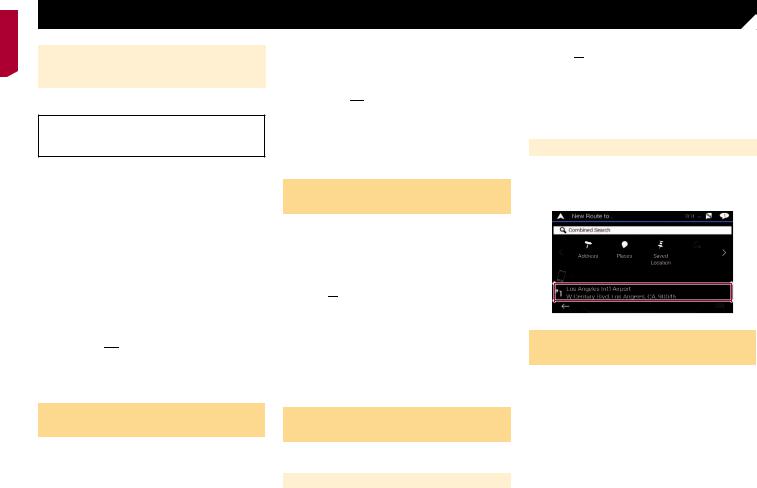
 Searching for a destination
Searching for a destination
Searching for providers nearby that offer emergency or roadside assistance services
 Important
Important
Never use this product to route to hospitals, police stations or similar facilities in an emergency. Stop using any functions relating to the hands-free phoning and please call the appropriate emergency number.
You can search for locations that provide emergency or roadside assistance in the surrounding areas.
pThis information does not necessarily correspond to actual information. Utilize the information for your reference.
1Press the MAP button and touch  .
.
2Touch [Useful Information].
3Touch [Help Nearby].
The preset search categories are as follows.
Car Repair
Health
Police
Gas Station
4Touch the category.
5Touch the POI.
The searched location appears on the map screen.
If you touch 

 , you can change the sort method of the results.
, you can change the sort method of the results.
6 Touch [Select as Destination], and then touch [Start Navigation].
Your navigation system starts the route guidance.
Selecting a destination from stored locations
Storing locations you visit frequently saves time and effort. Selecting an item from the list provides an easy way to specify the position.
The list of saved locations contains two preset categories: Home and Work.
pThis function is available if locations have been registered in “Saved Location”.
Refer to Storing a location in “Saved Location” on page
16 20
1Press the MAP button and touch  .
.
2Touch [New Route].
3Touch [Saved Location].
If you touch 

 and then [Edit], you can edit the details of saved locations.
and then [Edit], you can edit the details of saved locations.
4Touch the entry.
The searched location appears on the map screen.
5 Touch [Select as Destination], and then touch [Start Navigation].
Your navigation system starts the route guidance.
Selecting a destination from stored routes
Storing routes you use frequently saves time and effort.
pThis function is not available if no routes have been registered in “Saved Routes”.
Refer to Storing a route in “Saved Routes” on page 20
1Press the MAP button and touch  .
.
2Touch [New Route].
3Touch 

 to show the next page.
to show the next page.
4Touch [Saved Routes].
5Touch the entry.
pYou can add waypoints or change the final destination on the “Route Planner” screen.
Refer to Building a route using “Route Planner” on page 18
6 Touch [Show Route], and then touch [Start Navigation].
Your navigation system starts the route guidance.
Selecting a location you searched for recently
The places that were previously set as destinations or waypoints have been automatically stored in “History”.
History
1Press the MAP button and touch  .
.
2Touch [New Route].
3Touch 

 to show the next page.
to show the next page.
4Touch [History].
5Touch the entry.
The searched location appears on the map screen.
6 Touch [Select as Destination], and then touch [Start Navigation].
Your navigation system starts the route guidance.
Smart History
Smart History suggests these previously used locations as destinations based on your navigation habits, using parameters like the current time of day, the day of week, and the current location. Smart History items are shown in the “New Route to...” screen for easy access.
Searching for a location using “Combined Search”
The “Combined Search” feature lets you quickly find a place by its name and search area.
pThe “Combined Search” function also searches your stored data.
1Press the MAP button and touch  .
.
2Touch [New Route].
3Touch [Combined Search].
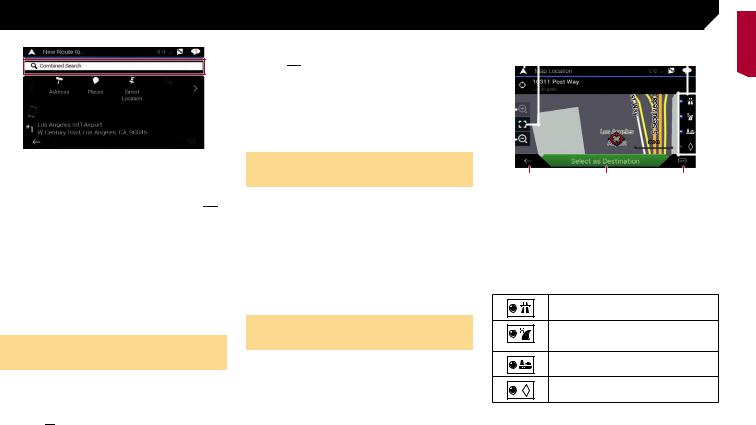
 Searching for a destination
Searching for a destination
4Touch the right text box to enter the country and city/town.
5Enter the name, address, or category of the destination to the left text box, then touch 

 .
.
6Touch the entry.
The searched location appears on the map screen.
7Touch the right of the list to narrow down the search results.
If you touch a map data provider logo, you can narrow down the list of results by showing the results from the provider.
8Touch [Select as Destination], and then touch
[Start Navigation].
Your navigation system starts the route guidance.
Searching for a location by the coordinates
Entering a latitude and longitude pinpoints the location.
1Press the MAP button and touch  .
.
2Touch [New Route].
3Touch 

 to show the next page.
to show the next page.
4Touch [Coordinates].
5Enter the latitude value and touch [OK].
pWhen a value is already entered in the text field, delete the value first.
pYou can change the display format of the latitude and longitude to any of the following formats: decimal degrees; degrees and decimal minutes; or degrees, minutes and decimal seconds.
When entering the coordinates in UTM format, touch 

 , then [UTM Coordinates].
, then [UTM Coordinates].
6 Enter the longitude value and touch [Go!].
pWhen a value is already entered in the text field, delete the value first.
The searched location appears on the map screen.
7 Touch [Select as Destination], and then touch [Start Navigation].
Your navigation system starts the route guidance.
Searching for a location by scrolling the map
Specifying a location after scrolling the map enables you to set the position as a destination or waypoint.
1Press the MAP button.
2Touch and drag the screen to scroll the map.
3Touch the location that you want to select as
your destination.
The cursor appears.
4 Touch [Select as Destination], and then touch [Start Navigation].
Your navigation system starts the route guidance.
Using the “Map Location” screen
Once a location is searched, the “Map Location” screen appears. You can select some options for the route or displayed map location before route calculation.
1 2 3 |
4 |
||||||
|
|
|
|
|
|
|
|
|
|
|
|
|
|
|
|
|
|
|
|
|
|
|
|
|
|
|
|
|
|
|
|
|
|
|
|
|
|
|
|
|
|
|
|
|
|
|
|
|
|
|
|
|
|
|
|
5 |
6 |
7 |
p If you touch the map, the cursor is placed at that position. Also, you can scroll the map by dragging the map.
1 Zoom in/zoom out
p You can also pinch or expand the map to zoom in or out.
2Cancels the “Map Location” screen and displays the map of the current position.
3Returns the cursor to the initial position and the map scale to the initial scale.
4Shows the route setting preferences for route calculation. Touch the keys to activate or deactivate the preference.
Calculates the route prioritizing the use of freeways when the key is activated.
Calculates the route prioritizing the use of per-use charged toll roads when the key is activated.
Calculates the route prioritizing the use of ferries when the key is activated.
Calculates the route prioritizing the use of carpool and HOV lanes when the key is activated.
5Returns to the previous screen.
6Sets the cursor position to your destination (or waypoint).
7Displays the shortcuts.
Detailed Information:
Shows the detailed information of the point.
Save Location:
Saves the displayed location as your favorite location. The saved location can be easily recalled later.
Places Around Cursor:
Searches for POIs around the displayed location. Touch
the POI to show the “Map Location” screen, and also set |
|
the POI as the destination (or waypoint). |
17 |
|
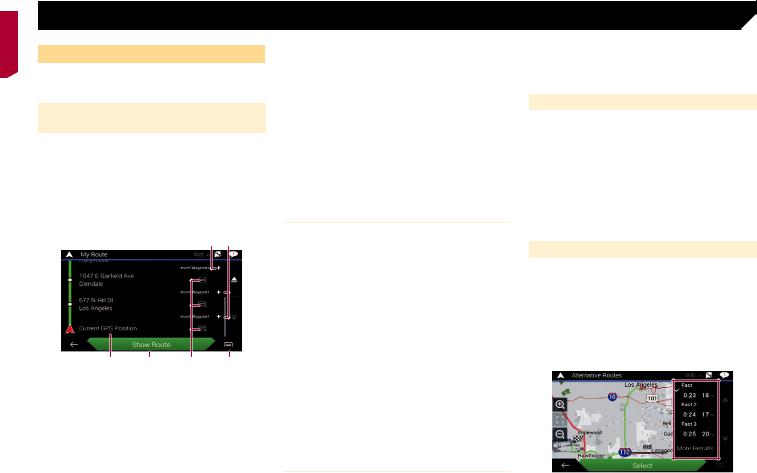
 Checking and modifying the current route
Checking and modifying the current route
Modifying the route
When navigation is already started, there are several ways to modify the current route. The following sections describe some of those options.
Building a route using “Route
Planner”
The “Route Planner” (or “My Route”) feature lets you build your route using the list of destinations.
Editing the list allows you to plan your route easily.
pOnce you set the route, you can edit your route using the menu displayed as “My Route”.
1Press the MAP button and touch  .
.
2Touch [Route Planner] or [My Route].
3Touch one of the options.
6 5
1 2 3 4
1Starting position (The current vehicle position is set as default and [Current GPS Position] is displayed.)
Refer to Changing the starting position on page 18
2Calculates the route and shows the “Route Summary” screen.
3Displays the options for the location.
Move Up/Move Down:
Edits the order you want to visit the locations.
Delete:
Deletes the destination or waypoint.
Save Location:
Stores the location in “Saved Location”.
Refer to Storing a location in “Saved Location” on page 20
Change:
Changes the destination or waypoint to another location.
18 |
Show on Map: |
|
Shows the selected location on the map.
4Displays the shortcuts.
Delete All:
Deletes all waypoints and the destination. Touch [Continue Without Route] to cancel the planned route.
Optimize Waypoints:
Changes the order of waypoints automatically so that the route can be easily traveled. (If the resulting order is the same as the current order, this option is invalid.)
Optimize Route:
Changes the order of all waypoints and the destination automatically so that the route can be easily traveled. (If the resulting order is the same as the current order, this option is invalid.)
5Inserts a new waypoint.
6Adds a new destination and changes the current destination to the last waypoint.
Changing the starting position
The starting position for route can be changed from the current position.
1Press the MAP button and touch  .
.
2Touch [Route Planner] or [My Route].
3Touch [Current GPS Position].
4Touch [Set Start Point] or [Change Start Point] and then touch [OK].
5Search for a location.
6Touch [Set Start Point] or [Change Start Point].
The selected position is set as the starting position for route calculation.
7Touch [Show Route] or [Continue Without
Route].
The system starts route recalculation after [Show Route] is touched, and then the “Route Summary” screen appears. After [Start Navigation] is touched, your navigation system starts the route guidance.
After [Continue Without Route] is touched, the current position map appears.
Restoring the current position as the starting position
1Press the MAP button and touch  .
.
2Touch [Route Planner] or [My Route].
3Touch [Current GPS Position].
4 Touch [Back to GPS Position] and then touch [Delete Start Point].
The starting position for route calculation returns to the current position.
Adding waypoints
1Press the MAP button and touch  .
.
2Touch [Add Waypoint].
3Search for a location.
4Touch [Select as Waypoint].
The route is recalculated, and the “Route Summary” screen appears. (When the waypoint is already set, the “My Route” screen appears. Touch [Show Route] and proceed to the next step.)
5 Touch [Start Navigation].
Your navigation system starts the route guidance.
Checking route alternatives
You can select another route and compare different route alternatives.
1Press the MAP button and touch  .
.
2Touch [Detours & Alternatives].
3Touch [Alternative Routes].
4Touch any of the route calculate conditions.
You can see the approximate time required and total distance of selected route alternatives. Touch any of the route alternatives to see it on the map.
pIf more than three route alternatives have been found, [More Results] appears. Touch [More Results] to show the other routes.
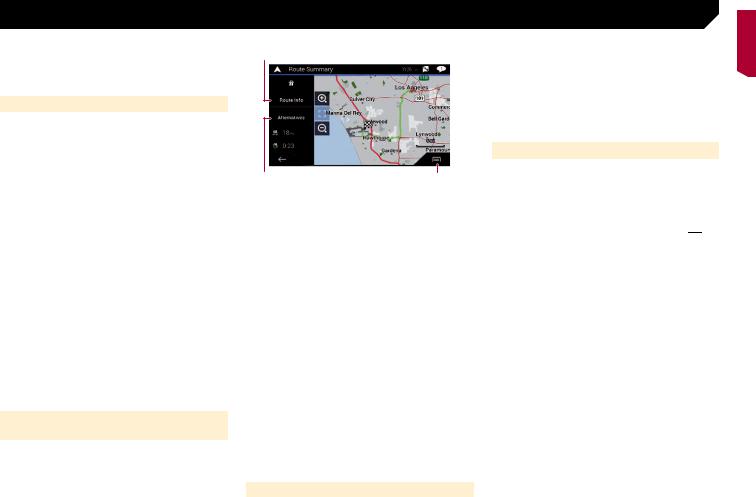
 Checking and modifying the current route
Checking and modifying the current route
For information about route calculation conditions, refer to Route Planning Method on page 25
5 Touch [Select].
The selected route is applied as your current route.
Checking detour routes
You can check for detour routes that avoid the selected sections or streets, or that avoid the road ahead. You can also check for alternative routes.
1Press the MAP button and touch  .
.
2Touch [Detours & Alternatives].
3Touch one of the options.
Alternative Routes:
Shows the alternative routes.
Refer to Checking route alternatives on page 18
Avoid Special Sections:
Shows the route avoiding certain sections. Touch the list item to select the section you want to avoid. The distance and time difference, suggested route, current route, and the section avoided are shown. Touch [Accept] to apply the suggested route.
Avoid Specific Road:
Shows the route avoiding certain road. Touch the list item to select the road you want to avoid. Distance and time difference, suggested route, current route, section avoided are shown. Touch [Accept] to apply the suggested route.
Avoid Road Ahead:
Shows the route avoiding the road ahead. Touch [+] or [–] to set the distance you want to avoid. Touch [Avoid] to apply the suggested route.
Restore Original Route:
Cancels the route with avoidances and restores the previous
route.
pThe route set by [Alternative Routes] cannot be canceled.
Checking route information and preferences
Once you set the route, you can check a summary of the current route.
1Press the MAP button and touch  .
.
2Touch [Route Summary].
3Touch one of the options.
3
1 |
2 |
The conditions of the displayed route is shown in the upper left by icon. The total length of the route and approximate required time for the route in the lower left.
p You can scroll the map by dragging the map.
1Shows alternative routes.
Refer to Checking route alternatives on page 18
2Displays the shortcuts.
Route Preferences:
Shows the route setting preferences. If you change the preferences, the route is recalculated.
Itinerary:
Shows all transit points in detail. Touch a transit point to show its position on the map. If you touch [Avoid] on the map screen, the route is recalculated avoiding the transit point (as much as possible).
Save Route:
Saves the displayed route. The saved route can be recalled later.
Places Along Route:
Searches for POIs along the displayed route. Touch the POI to show the “Map Location” screen, and also set the POI as a waypoint.
Simulation:
You can run a simulation of the navigation for the current route, as a demonstration.
Refer to Watching the simulation of the route on page 19
3Shows the information for a transit point on the route. Touching the items allows you to see the location on the map. Touch [Avoid] and [Accept] to set the location as a location to avoid.
Canceling the current route guidance
If you no longer need to travel to your destination, follow the steps below to cancel the route guidance.
1Press the MAP button and touch  .
.
2Touch [Cancel Route] or [Delete Waypoint].
3Touch one of the options.
If there are no waypoints on the route, touch [Cancel Route] to cancel the route.
If there are waypoints on the route, touch [Cancel Route] to cancel the route. Touch [Delete Waypoint] to delete only the nearest waypoint. In such case, the route is recalculated.
Watching the simulation of the route
You can run a simulation of the navigation for the current route, as a demonstration.
1 Set a route to your destination.
Refer to Searching for a destination on page 14
2Press the MAP button and touch  .
.
3Touch [Route Summary], and then touch 

 .
.
4Touch [Simulation].
The simulation starts from the starting point of the route, and using a realistic speed, it leads you through the whole recommended route.
Touch [Close] to stop the simulation.
19

 Registering and editing locations and routes
Registering and editing locations and routes
Storing a location in “Saved Location”
Storing your favorite locations in “Saved Location” allows you to save the time and effort used on re-entering this information. “Saved Location” can include your home location, workplace, and places you have already registered.
Storing your home and your workplace location
You can store one home location and one workplace location.
1Press the MAP button and touch  .
.
2Touch [New Route], and then [Saved Location].
You can also display the “Saved Location” screen by touching
 on the bottom of the screen when the navigation menu is displayed.
on the bottom of the screen when the navigation menu is displayed.
3Touch [Home] or [Work] and then touch [OK]. p When you have already stored your home or workplace,
touch [Home] or [Work] to show the location on the “Map Location” screen.
4Search for a location.
Refer to Searching for a destination on page 14
5 Touch [Add to Saved Locations].
The cursor position has been stored.
Storing your favorite locations
You can store a frequently visited location (such as a relative’s home) to allow easy routing.
1Press the MAP button and touch  .
.
2Touch [New Route], and then [Saved Location].
You can also display the “Saved Location” screen by touching
 on the bottom of the screen when the navigation menu is displayed.
on the bottom of the screen when the navigation menu is displayed.
3Touch [Add Location].
4Search for a location.
Refer to Searching for a destination on page 14
5Touch [Add to Saved Locations].
6Enter the name if needed and then touch


 .
.
pIn the on-screen keyboard, touching 

 or
or 

 enables you to store the location as your home or workplace location.
enables you to store the location as your home or workplace location.
Editing stored locations
Stored locations can be edited.
Switching to the edit mode
1Press the MAP button and touch  .
.
2Touch [New Route], and then [Saved Location].
3Touch  , and then touch [Edit].
, and then touch [Edit].
The “Select Location to Edit” screen appears.
Renaming stored locations
1 Switch to the edit mode.
Refer to Switching to the edit mode on page 20
2 Touch the item you want to rename and touch [Rename].
p“Home”and “Work” cannot be renamed. The location can be set again.
3Enter the name and then touch 

 .
.
4Touch [Done].
Deleting stored locations
1 Switch to the edit mode.
Refer to Switching to the edit mode on page 20
2 Touch the item you want to delete and touch [Delete].
p“Home” and “Work” cannot be deleted. The location can be set again.
pIf you touch 

 and then touch [Delete All], all entries
and then touch [Delete All], all entries
(including the home and workplace locations) can be deleted.
A message will appear asking you to confirm the deletion.
3Touch [OK].
4Touch [Done].
Storing a route in “Saved Routes”
1 Set a route to your destination.
Refer to Searching for a destination on page 14
2Press the MAP button and touch  .
.
3Touch [Route Summary], and then touch 

 .
.
4Touch [Save Route].
5Enter the name if needed and then touch


 .
.
Editing the stored route
Stored routes can be edited.
Renaming stored routes
1Press the MAP button and touch  .
.
2Touch [New Route], and then 

 .
.
3Touch [Saved Routes].
4Touch 

 , and then touch [Edit].
, and then touch [Edit].
5Touch the item you want to rename and touch [Rename].
6Enter the name and then touch  .
.
7Touch [Done].
Deleting stored routes
1Press the MAP button and touch  .
.
2Touch [New Route], and then 

 .
.
3Touch [Saved Routes].
4Touch 

 , and then touch [Edit].
, and then touch [Edit].
5Touch the item you want to delete and touch
[Delete].
pIf you touch 

 and then touch [Delete All], all entries can be deleted.
and then touch [Delete All], all entries can be deleted.
6 Touch [Delete].
The cursor position has been stored.
20
Storing your favorite routes in “Saved Routes” allows you to save the time and effort used on re-entering this information.

|
|
|
Registering and editing locations and |
|
|
|
|
Receiving real- |
|
|||||
|
|
|
routes |
|
|
|
|
|
|
|
time traffic infor- |
|
||
|
|
|
|
|
|
|
|
|
|
|
mation (TMC) |
|
||
|
|
|
|
|
|
|
|
|
|
|
|
|||
Saving a location as an alert |
|
Editing the stored alert points |
|
|
|
|
|
|
|
|
||||
|
|
|
|
|
|
|
|
|
||||||
point |
|
Stored alert points can be edited. |
|
The Traffic Message Channel (TMC) provides real-time traffic |
|
|||||||||
|
Important |
|
1 Press the MAP button. |
|
reports. If the navigation system is equipped with the TMC fea- |
|
||||||||
|
|
2 Scroll the map and move the cursor over the |
|
ture, you can check the traffic reports and information received. |
|
|||||||||
|
|
|
|
|
|
p The online function in “Traffic” can be used if you connect |
|
|||||||
|
|
|
|
|
|
stored alert point, and then touch . |
|
|
an iPhone or a smartphone that has the AVICSYNC App |
|
||||
The warning for road safety cameras (like speed cameras) is |
|
|
|
|
|
|||||||||
|
3 Touch [Edit Alert Points]. |
|
|
installed. |
|
|||||||||
disabled when you are in certain countries where warnings |
|
|
|
|
||||||||||
|
|
|
Be sure read Expanding the use of the navigation functions |
|
||||||||||
for road safety cameras are prohibited. However, you are |
|
4 Set the necessary parameters. |
|
|
|
|||||||||
|
|
|
(page 29) before using the AVICSYNC function. |
|
||||||||||
fully responsible for ensuring that this feature is legal in the |
|
|
|
|
||||||||||
|
|
If you touch and then touch [Delete], the |
|
p |
5200NEX |
|
||||||||
country where you intend to use it. |
|
|
|
|||||||||||
|
|
|
The traffic information feature can be used when the online |
|
||||||||||
|
|
|
|
|
|
selected alert point will be deleted. |
|
|
|
|||||
|
|
|
|
|
|
|
|
traffic feature is available. |
|
|||||
You can save any map location (such as a school zone or railroad |
|
|
|
|
|
|
||||||||
5 |
Touch [Edit]. |
|
|
|
|
|
|
|
|
|||||
crossing) as an alert point. |
|
|
|
|
Displaying the “Traffic |
|
||||||||
p To use this function, activate the warnings beforehand and |
|
|
|
|
|
|||||||||
|
set the alert types. |
|
|
|
|
Summary” screen |
|
|||||||
|
Refer to “Warnings” settings on page 26 |
|
|
|
|
|
||||||||
|
|
|
|
|
|
|
|
|
|
|
|
|||
1 Press the MAP button. |
|
|
|
1 |
Press the MAP button and touch |
|
. |
|
||||||
|
|
|
|
|
||||||||||
|
|
|
|
|
||||||||||
|
|
|
|
|
||||||||||
2 Scroll the map and select a location. |
|
|
|
2 |
Touch [Traffic]. |
|
||||||||
The cursor appears at the selected point. |
|
|
|
|
The “Traffic Summary” screen appears. |
|
||||||||
3 |
Touch . |
|
|
|
|
|
|
|
|
|
|
|
||
4 Touch [Add Alert Points]. |
|
|
|
|
Viewing the traffic list |
|
||||||||
5 Set the necessary parameters. |
|
|
|
|
Traffic information is displayed onscreen in a list. This allows you |
|
||||||||
|
Alert Type: |
|
|
|
|
to check how many traffic incidents have occurred, the loca- |
|
|||||||
|
Sets the type of the alert point. |
|
|
|
|
tions, and the distance from your current position. |
|
|||||||
Speed Limit: |
|
|
|
|
1 Display the “Traffic Summary” screen. |
|
||||||||
|
Sets the speed limit for this alert point (if applicable). |
|
|
|
|
Refer to Displaying the “Traffic Summary” screen on page |
|
|||||||
Direction: |
|
|
|
|
|
|||||||||
|
|
|
|
|
21 |
|
|
|
|
|
||||
|
Sets the direction from which you expect the alert to come |
|
|
|
|
|
|
|
|
|
|
|||
|
|
|
|
2 |
Touch [Traffic Events]. |
|
||||||||
|
from. |
|
|
|
|
|||||||||
6 |
Touch [Save]. |
|
|
|
|
|
|
|
|
|
|
|
||
A list with traffic information that has been received is shown.
The list is sorted by distance from your current position. Places
21
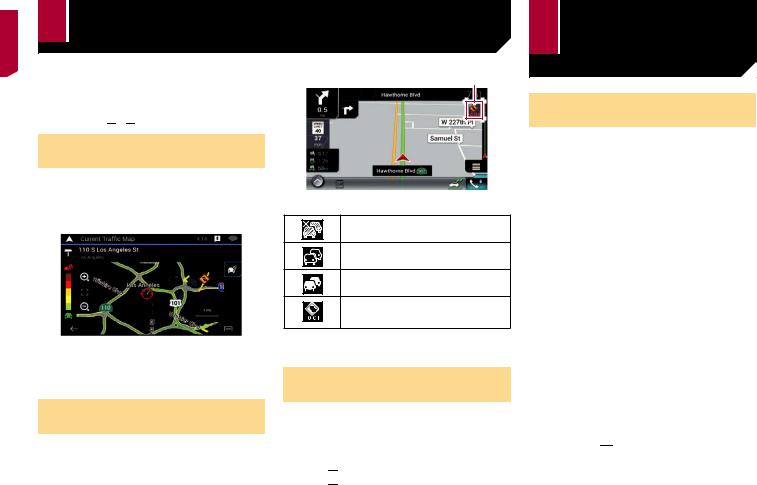
Receiving real-time traffic information  (TMC)
(TMC)
(street names) where incidents have occurred are displayed on the list.
pIf a route is set, relevant events for your current route are shown in the upper section of the list.
pTouching the desired item allows you to check its position on the map. Touch 

 or
or 

 to show the previous or next event.
to show the previous or next event.
Checking the traffic incidents on the map
Traffic event information can be displayed on the map.
1 Display the “Traffic Summary” screen.
Refer to Displaying the “Traffic Summary” screen on page 21
2 Touch [Traffic Map].
Road segments affected by traffic incidents are displayed in an alternate color on the map, and small symbols above the road show the nature of the incident.
The traffic congestion lines indicate the degree of the congestion by color.
When traffic incidents occur on your route
The notification icon shows the status of traffic information reception.
1Touch the relevant traffic event icon on the map.
1
1 Traffic notification icon
Indicates that there are no traffic incidents in your coverage area.
Indicates that information on traffic incidents are being received.
Indicates that there are no significant traffic incidents on your route.
Indicates that there are significant traffic incidents on your route. The icon shows the type of the next traffic incident.
You can check the details of the traffic incidents. Touch the relevant event to display the location on the map.
Turning the traffic information on or off
The traffic information feature is turned on by default. To enable or disable the TMC feature, perform the following procedure.
pIf you turn the traffic information feature off, [Traffic] on the navigation menu disappears.
1Press the MAP button and touch  .
.
2Touch 

 , and then touch [Settings].
, and then touch [Settings].
3Touch 

 , and then touch [Traffic].
, and then touch [Traffic].
4Touch [Traffic] to turn the switch on or off.
Checking useful information  about your trip
about your trip
Displaying the “Useful
Information” menu
The “Useful Information” menu contains various information to support your driving.
pTo use the online functions (“Parking”, “Weather” and “Fuel Prices”), the appropriate content installation must be installed in the navigation system and a connection with an iPhone or a smartphone that has the AVICSYNC App installed must be established.
Be sure read Expanding the use of the navigation functions
(page 29) before using the AVICSYNC function.
1Press the MAP button and touch  .
.
2Touch [Useful Information].
The “Useful Information” screen appears.
Information on each option in the “Useful Information” menu
Parking:
Checks for parking lots near your current location.
Refer to the manual for AVICSYNC on our website
Fuel Prices:
Displays recent gas prices of gas stations near the current location, along the current route, or in the town.
Refer to the manual for AVICSYNC on our website
Weather:
Checks the weather forecast for your current location, along your route, around your destination, as well as for your saved locations.
Refer to the manual for AVICSYNC on our website
Where Am I?:
Displays a special screen with information about the current position and a key to search for nearby emergency or road-
side assistance services.
pTo save the current position as a “Saved Location” destination, touch 

 .
.
Refer to Storing a location in “Saved Location” on page 20
Help Nearby:
Checks for POIs in your surroundings.
The preset search categories are as follows.
—Car Repair:
—Health:
—Police:
—Gas Station:
22
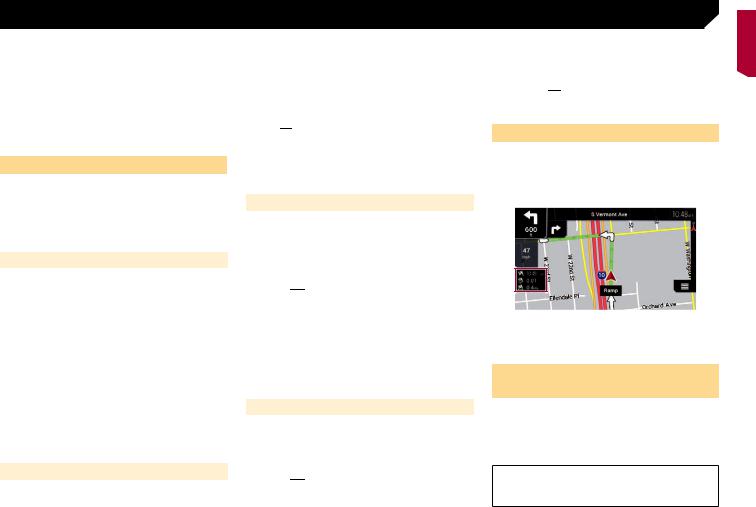
 Checking useful information about your trip
Checking useful information about your trip
Trip Monitor:
Checks the statistical data of your trips (for example, start time, end time, average speed, etc.).
Refer to Recording your travel history on page 23
GPS Information:
Displays the GPS information screen with satellite position and signal strength information.
Fuel Consumption:
You can estimate the fuel cost to your destination by entering the fuel consumption information in the navigation system.
Refer to Calculating the fuel consumption on page 23
Recording your travel history
Activating the trip logger enables you to record your driving history (hereinafter called “trip log”). You can review your trip log later.
pThe trip logger is set so that it can be started manually by default. You can change the settings of this function in order
to save the log automatically.
Refer to “Trip Monitor” settings on page 28
Activating trip logger temporarily
One-time activation is useful if you want to create a log only for a particular trip.
1 Display the “Useful Information” menu.
Refer to Displaying the “Useful Information” menu on page 22
2 Touch [Trip Monitor].
A list of trip logs already recorded appears. A blank list appears if you have not recorded any trip logs yet.
3 Touch [Start New Recording].
The trip logger is activated. The touch key changes to [Stop Recording]. Touching [Stop Recording] allows you to deactivate the trip logger.
pIf there is not enough space in the built-in memory, the oldest trip log will be overwritten by the new one.
pIf you want the system to always activate the trip logger whenever the GPS signal is available, turn on “Enable
Auto-Saving”.
Refer to Setting the trip logger on page 23
Browsing the trip log
1Record the trip log.
2Display the “Useful Information” menu.
Refer to Displaying the “Useful Information” menu on page 22
3 Touch [Trip Monitor].
p To export all trip logs, touch [Export All].
4 Touch any of the items to see the details.
p To display the trip log on the map, touch [Visible on Map] to tick the check box.
Touching  allows you to view the shortcuts and enables you to use the following functions.
allows you to view the shortcuts and enables you to use the following functions.
View on Map
Shows the trip log on the map screen.
Export Track Log:
Exports the track log currently selected to an external storage device.
Setting the trip logger
1Record the trip log.
2Display the “Useful Information” menu.
Refer to Displaying the “Useful Information” menu on page 22
3Touch [Trip Monitor].
4Touch 

 and then touch [Trip Monitor Settings].
and then touch [Trip Monitor Settings].
5Touch any of the items to change the settings.
Enable Auto-Saving:
Sets whether automatic trip logging is activated or not.
Save Track Log:
Track logs, the sequence of the positions given by the GPS receiver, can be saved together with trip logs. You can acti-
vate the track logger whenever the trip logger is activated.
p“Trip Database Size” indicates the current data size of the trip log (track log included).
Editing a trip log
1 Display the “Useful Information” menu.
Refer to Displaying the “Useful Information” menu on page 22
2Touch [Trip Monitor].
3Touch 

 and then touch [Edit].
and then touch [Edit].
4Touch any of the items to edit.
Delete:
Deletes the trip log.
Rename:
Renames the trip log.
Change Color:
Changes the color by selecting another color from the color
table.
pIf you touch  and then touch [Delete All], all entries can be deleted.
and then touch [Delete All], all entries can be deleted.
5 Touch [Done].
Using the Trip Computer mode
In the trip computer screen, the information received from the GPS receiver and your vehicle is displayed like a meter for a vehicle.
1Press the MAP button.
2Touch the data field key.
pIf you touch [Trip Summary], the details of the current trip are displayed. Touch [Save Trip] to store the current trip log.
pIf you press the MAP button, you can return to the map screen.
Calculating the fuel consumption
The fuel consumption monitor helps you keep track of the fuel consumption of your car even if you do not use the navigation system for all your journeys. Set the initial odometer value and then record the distance driven and the amount of fuel whenever you fill up your car. You can also set reminders for regular car maintenance.
These calculations are based only on the information that you provide and not on any data from the vehicle. The fuel mileage displayed is only a reference value, and does not guarantee that the fuel mileage displayed can be obtained.
23

Checking useful information about your  trip
trip
Setting the initial odometer value
Before you use the fuel consumption feature, enter the initial odometer value from which you want to start measuring the mileage.
1 Display the “Useful Information” menu.
Refer to Displaying the “Useful Information” menu on page 22
2Touch [Fuel Consumption].
3Touch [Initial Odometer Value].
4Enter the initial odometer value and then touch
.
The initial odometer value has been set.
Entering the fuel consumption information
To calculate the fuel consumption for the distance you have traveled, enter the distance driven and the amount of fuel whenever you fill up your car.
1 Display the “Useful Information” menu.
Refer to Displaying the “Useful Information” menu on page 22
2Touch [Fuel Consumption].
3Touch [Add].
4Touch [Current Odometer Value] and then enter the current odometer value.
5Touch [Gas Amount] to enter the amount of fuel pumped this time.
6Touch [Gas Price / Unit] to enter the fuel unit price this time.
7Touch [Add].
8Touch [Done].
pTo delete an entry, touch 

 to display the shortcut for deletion.
to display the shortcut for deletion.
Setting the car maintenance schedule
1 Display the “Useful Information” menu.
24
Refer to Displaying the “Useful Information” menu on page 22
2Touch [Fuel Consumption].
3Touch 

 .
.
4Touch [Maintenance Schedule].
5Touch [Add] or the one of entries.
6Enter the name, date, and mileage for the reminder.
7Touch [Done].
pTo delete an entry, touch 

 to display the shortcut for deletion.
to display the shortcut for deletion.
Customizing preferences of  the navigation
the navigation
Customizing the navigation settings
You can configure the navigation settings, and modify the behavior of this system.
1Press the MAP button and touch  .
.
2Touch  , and then touch [Settings].
, and then touch [Settings].
The “Settings” screen appears.
Route Preferences:
Sets the type of vehicle you are driving, the road types used in route planning, and the route planning method.
Refer to “Route Preferences” settings on page 25
Sound:
Adjusts the different sound volumes and changes the voice guidance profile.
Refer to “Sound” settings on page 26
Warnings:
Enables or disables warnings and sets up the warning function.
Refer to “Warnings” settings on page 26
Navigation Map:
Fine-tunes the appearance of the map screen and adjusts how the software helps you navigate with different kinds of route-related information on the map screen.
Refer to “Navigation Map” settings on page 27
Regional:
Changes the voice guidance language, the application language, and measurement units.
Refer to “Regional” settings on page 27
Display:
Sets separate themes for daytime and nighttime use, adjusts the display backlight, and enables or disables menu animations.
Refer to “Display” settings on page 28
Traffic:
Enables or disables the traffic information feature.
Refer to “Traffic” settings on page 28
Weather:
Enables or disables the online weather forecast option and the automatic download of weather information.
Refer to the manual for AVICSYNC on our website
Fuel:
Enables or disables the online gas price option and sets up the gas type.

 Customizing preferences of the navigation
Customizing preferences of the navigation
Refer to the manual for AVICSYNC on our website
Trip Monitor:
Turns automatic trip log saving on or off and checks the current size of the trip database.
Refer to “Trip Monitor” settings on page 28
AVICSYNC
Displays the connection method for AVICSYNC.
pThe setting value is fixed. Use this product as it is.
Connected Services:
Enables or disables the connected services.
Refer to “Connected Services” settings on page 28
Start Configuration Wizard:
Modifies the basic software parameters used during the initial setup process.
SyncTool:
Starts the synchronization tool, which makes it possible to update your maps.
Refer to Getting the map update on page 29
Restoring the default settings
You can restore settings or recorded content to the default settings.
1Press the MAP button and touch  .
.
2Touch 

 , and then touch [Settings].
, and then touch [Settings].
3Touch 

 .
.
4Touch [Reset All Settings].
5Touch [OK].
The recorded contents are cleared.
pIf you touch [Factory Reset] on the shortcut, all data relevant to navigation (including the items in saved locations and histories) are deleted and all settings are reset to their factory defaults.
Information on each option of “Settings”
“Route Preferences” settings
Vehicle
You can set the type of vehicle you will be using on the route.
pThe route is planned based on the selected vehicle type. Route planning can also be configured to incorporate dimension, weight, and freight hazard restrictions for maps that contain such data.
To enhance the route accuracy, correctly select a vehicle type that is similar to the condition of your vehicle.
Car:
—Maneuver restrictions and directional constraints are taken into account when planning a route.
—Roads are used only if access for cars is allowed.
—Private roads and resident-only roads are used only if they are inevitable to reach the destination.
—Walkways are excluded from routes.
Emergency:
—All maneuvers available at intersections are taken into account.
—Directional constraints are taken into account in the same way as travel in the opposite direction is allowed at low speeds.
—Only private roads that need to be used to access the destination are included.
—Walkways are excluded from routes.
Bus:
—Maneuver restrictions and directional constraints are taken into account when planning a route.
—Roads are used only if access for buses is allowed.
—Private roads, resident-only roads and walkways are excluded from routes.
Taxi:
—Maneuver restrictions and directional constraints are taken into account when planning a route.
—Roads are used only if access for taxis is allowed.
—Private roads, resident-only roads and walkways are excluded from routes.
Truck:
—Maneuver restrictions and directional constraints are taken into account when planning a route.
—Only roads that allow truck access are included.
—Private roads, resident-only roads and walkways are excluded from routes.
—U-turns are not used in routes (turning around on a divided road is not considered a U-turn for the purpose of
this system).
pTo edit the name and estimated maximum speed of the selected vehicle profile, touch 

 .
.
pTo add a new vehicle profile, touch [Add Profile]. Then select one of the vehicle types and set the name and estimated maximum speed.
Route Planning Method
You can change the route planning method. Route calculation can be optimized for different situations and vehicle types by changing the planning method. The route planning method types are as follows.
Fast
Calculates a route with the shortest travel time to your destination as a priority. Usually the best selection for fast and standard cars.
Easy
Results in a route with fewer turns and no difficult maneuvers. With this option, you can make this system to take, for example, the freeway instead of a series of smaller roads or streets.
Short
Calculates a route with the shortest distance to your destination as a priority. Usually practical for slower vehicles. Rarely practical to use to search for shorter routes for normal vehicles regardless of the speed.
Economical
Calculates a route that is quick and saves fuel.
Navigation Mode
You can enable or disable off-road navigation.
On-road
The route is planned towards the destination along the roads on the map.
Off-road
The route is planned towards the destination in a straight line, not along the roads on the map.
Highways
When this function is turned off, the route is calculated prioritizing the avoidance of freeways.
This function is useful when you want to avoid freeways when you are driving a slow car or you are towing another vehicle.
Period Charge
When this function is turned off, the route is calculated prioritizing the avoidance of toll roads.
This function is useful when you want to avoid toll roads with restricted time access that require you to purchase a separate pass or vignette to extend the length of time allotted for use.
pThis option can be enabled or disabled separately from the pre-use toll road usage option.
Per-use Toll
When this function is turned off, the route is calculated prioritizing the avoidance of per-use charged toll roads.
This function is useful when you want to avoid toll roads where there is a per-use charge.
Ferries
When this function is turned off, the route is calculated prioritizing the avoidance of ferries.
25

 Customizing preferences of the navigation
Customizing preferences of the navigation
Car Shuttle Trains
When this function is turned off, the route is calculated prioritising the avoidance of car shuttle trains.
Car shuttle trains are used to transport vehicles for relatively short distances and they usually connect places that are not easily accessible by road.
Carpool Lanes
When this function is turned off, the route is calculated prioritizing the avoidance of carpool and HOV lanes.
pThe navigation system avoids carpool and HOV lanes by default.
Unpaved Roads
When this function is turned off, the route is calculated prioritizing the avoidance of unpaved roads.
p The navigation system avoids unpaved roads by default.
“Sound” settings
pThe following settings marked with an asterisk (*) are enabled only when a TTS-voice is selected for the voice language.
Voice
You can adjust the volume of the guidance sounds (verbal instructions).
Alert Beeps
You can adjust the volume of the non-verbal alert sounds (beeps).
Ding
You can turn off the attention tone that precedes the verbal instructions or adjust its volume.
Voice Guidance
You can enable or disable voice guidance. p This function is enabled by default.
Announce Streets and Roads in Native
Language Area*
You can select whether to have the navigation system announce the street names in the native language of the area, only the road numbers, or only the maneuvers.
Announce Streets and Roads in
Foreign Language Area*
You can select whether to have the navigation system read the street names in a foreign country, only the road numbers, or only the maneuvers.
Early Indication of Maneuvers
You can select whether you want an immediate announcement for the next maneuver or to receive the information when the maneuver is near.
Verbosity Level
You can set the verbosity of the voice instructions: how much information is given and how often the prompts occur.
Minimal: Voice instructions are given once right before the next maneuver.
Medium: Voice instructions are given once as the vehicle approaches the next maneuver and it is repeated right before the maneuver.
Verbose: Voice instructions are given once relatively far from the next maneuver, it is repeated as the vehicle approaches the next maneuver, and it is repeated again right before the actual maneuver.
Announce Route Summary*
You can select whether to have the navigation system announce by voice a quick summary of the route whenever a route is calculated.
Announce Country Info*
When you cross country borders, this navigation system can read out information about the country you have just entered.
pThis function is not effective if the map coverage of your navigation system is only one country (technically, there is no country border data).
Announce Traffic Info*
You can select whether to have the navigation system announce by voice the traffic information whenever a traffic incident on your route is received.
Announce System Messages*
When a system message appears, this navigation system can read out the message.
“Warnings” settings
 Important
Important
This system is able to warn you if you exceed the current speed limit. This information may not be available for your region (ask your local dealer), or may not be fully correct for all roads on the map.
You are liable for ensuring that using this feature is legal in the country where you intend to use it.
Speed Warning
Warn When Speeding
You can select whether you want to receive visible and/or audible warnings.
The following alert types are available:
—Audio and Visual: When selected, audible and visible warnings will go off when you exceed the speed limit.
—Visual: When selected, visible warnings will go off when you exceed the speed limit.
—Disabled: When selected, no warnings will go off.
Speed Limit Always Visible
You can select whether you want to see the speed limit sign on the map all the time. When you set the speed limit to always be visible, the color of the speed limit sign changes when you exceed the speed limit.
Outside Cities: ***% of the Speed Limit
You can receive a warning when you reach the set percentage of the speed limit in rural areas.
Within Cities: ***% of the Speed Limit
You can receive a warning when you reach the set percentage of the speed limit in urban areas.
Alert Points
This setting allows you to receive a warning when approaching alert points like school zones or railroad crossings.
Refer to Setting the alert point warnings on page 28
Warning Road Signs
Maps may contain driver alert information. Touch this key to turn on or off these warnings and to set the distance from the hazard to receive the warning at. These can be set individually for the different warning types.
26

 Customizing preferences of the navigation
Customizing preferences of the navigation
“Navigation Map” settings
Map Display
You can see the effect when you change a setting.
Viewpoint
You can adjust the basic zoom and tilt levels to your needs. Some preset levels are available. If you select “Manual”, you can store adjusted map scales and view angles.
Color Mode
You can switch between daytime and nighttime color modes or let the software switch between the two modes automatically a few minutes before sunrise and a few minutes after sunset.
Day Map Color
You can select the color scheme used in the daytime map.
Night Map Color
You can select the color scheme used in nighttime map.
Landmarks
This setting shows or hides 3D landmarks which are 3D artistic or block representations of prominent or well-known
objects.
p6200NEX/5200NEX
This function becomes effective only when the additional map data is installed.
Buildings
This setting shows or hides 3D city models which are 3D artistic or block representations of complete city building data containing actual building sizes and actual positions on the map.
p6200NEX/5200NEX
This function becomes effective only when the additional map data is installed.
3D Terrain
This setting shows or hides the 3D elevation of the surrounding terrain.
Track Logs
You can turn on or off track log saving which saves the sequence of the locations you go through on your journeys.
Place Markers
You can select which POI icons to show on the map while navigating.
pWhen a large number of POI icons exist on a map display, maps and POI icons become hard to see. To maintain map and POI visibility, reduce the displayed categories as much as possible.
Data Fields
You can choose to have different values displayed for when navigating a route to a select destination and for when just cruising around without any particular destination.
Refer to Browsing the data field on page 14
“First”, “Second” and “Third” selects items displayed in the data fields shown when the route exists. “Without Route” selects the items displayed in the data fields shown when a route does not exist.
Route Progress Bar
You can turn on the route progress bar to display the current route as a straight line located on the right side of the map. The arrow represents your current position and moves up the line as you travel along the route.
Offer Freeway Services
You may need to stop by a gas station or a restaurant during your journey.
Refer to Frequently shown route events on page 13
Services Displayed
You can select the service types displayed for the freeway exits or service stations. Choose from the POI categories.
Automatic Overview
When selected, the map zooms out to show an overview of the surrounding area if the next route event (maneuver) is far. When you get close to the event, the map returns to the normal map view.
Signposts
Whenever adequate information is available, lane information similar to the real ones on road signs above the road is displayed at the top of the map. You can turn this feature on or off.
Junction View
If you are approaching a freeway exit or a complex intersection and the necessary information is available, the map is replaced with a 3D view of the junction.
Tunnel View
When entering tunnels, the surface roads and buildings can be distracting. This feature shows a generic picture of a tunnel instead of the map. A top-down overview of the tunnel and remaining distance are also displayed.
Offer Congestion Detour on Highways
When you slow down while driving on a freeway due to a traffic congestion, this navigation system offers you a detour using the next exit. The message shows you the distance to the exit and the difference in the distance and estimated time compared to the original route. You can choose from one of the following options:
Touch [Dismiss] or just ignore the message if you want to keep the original route.
Touch [Preview] to see an overview of the original route and the detour to make the decision. You can accept the detour as shown in the preview, or increase the freeway segment bypassed before accepting.
Turn to the suggested new direction and the route will be automatically recalculated.
Offer Real Time Alternative Routes
Alternative routes can be suggested when driving on normal roads. This navigation system will select a different turn in the upcoming intersection and offer you a different route for the next section of the route. You cannot, however, modify the offered detour.
Offer Parking Around Destination
Parking at the destination may not be easy to find in city areas. As you approach the destination, this navigation system can offer parking category places near your destination. Touch 
to open a top-down map with the destination and the offered parking places. The route is calculated by selecting one of the parking places.
Offer Hints Upon Detour
If you leave the recommended route and suddenly exit the freeway, this navigation system offers different alternatives near the exit like gas stations or restaurants. Also, if there are avoidable parts of the original route ahead (like a tunnel, a toll road or a ferry), you will find them in the list in case you want to bypass them with the help of this navigation system.
“Regional” settings
Language
This key displays the current language of the user interface. By touching the key, you can select a new language from the list of available languages. This system will restart if you change this setting.
Voice Language
This key displays the current voice guidance profile. By touching the key, you can select a new voice guidance language from the list of available languages and speakers. Touch any of these keys to hear a sample voice prompt.
Units and Formats
You can set the various units to be used by this system.
27

 Customizing preferences of the navigation
Customizing preferences of the navigation
pThis system may not support all the listed units in some voice guidance languages.
Distance
The unit of distance can be changed.
Fuel Economy
The unit of fuel mileage can be changed.
Weight
The unit of weight can be changed.
Temperature
The unit of temperature can be changed.
Coordinate Display Format
The format of the coordinates can be changed.
Currency
The currency unit can be set.
Time Zone
By default, the time zone is taken from the map information and adjusted according to your current location.
Automatic Time Zone
The time zone setting changes automatically.
Manual Time Zone
The present setting value for the time difference and daylight saving time that you set are used.
Manual Time Zone if Auto Unavailable
The time zone setting changes automatically if automatic change is available. Otherwise, the present setting value that you set is used.
Manual Time Zone in Current Zone
The present setting value that you set are used in the current time zone. If your vehicle moves to another time zone, the
time zone setting changes automatically.
pIf a setting other than “Automatic Time Zone” is selected, “Time Zone” (the option to set the time difference manually) and “Daylight Saving Time” (the option to turn on or off daylight saving time) can also be set.
“Display” settings
Menu Animations
When animation is turned on, the keys on the menus and keyboard screens appear in an animated way. Screen transitions are also animated.
Day Skin Theme
You can select the style and colors of the navigation menu used in the daytime.
28
Night Skin Theme
You can select the style and colors of the navigation menu used in the nighttime.
“Traffic” settings
Traffic
You can set to enable or disable the TMC receiver that can receive real-time traffic information.
Data Source
You can select what data source you want to use for receiving real-time traffic information. [Online] is available only if the device is enabled.
Use Traffic Info
You can select whether to have traffic incidents be taken into consideration when the route is calculated.
Show Traffic Info
You can select whether to show icons relevant to traffic incidents and lines indicating the traffic flow on the map.
Off
No traffic icons or lines indicating the traffic flow are shown.
Color
Only the line relevant traffic incidents are shown on the map.
Color And Icon
Icons for the relevant traffic incidents and lines indicating the traffic flow are shown on the map.
Show Free Traffic Flow As Well
You can select whether to receive information on smooth traffic flow.
Offer Detour if it Saves at Least
You can set the minimum time to be saved when having the system suggest a detour route. If the estimated time saved by the planned detour avoiding the traffic incidents is more than the set time, the system suggests the new detour route. Otherwise, the new route is not suggested.
Confirm Detours Manually
You can enable or disable the manual confirmation of every recalculation.
“Trip Monitor” settings
Enable Auto-Saving
Refer to Setting the trip logger on page 23
Save Track Log
Refer to Setting the trip logger on page 23
“Connected Services” settings
You can use the “Connected Services” settings to enable or disable connected online features.
Refer to Expanding the use of the navigation functions on page 29
Online Traffic
You can enable or disable the online traffic service.
Online Weather
You can enable or disable the online weather forecast service.
Online Parking
You can enable or disable the online parking service.
Online Fuel Prices
You can enable or disable the online gas price service.
Online Search
You can enable or disable the online search service.
Setting the alert point warnings
 Important
Important
The warning for road safety cameras (like speed cameras) is disabled when you are in certain countries where warnings for road safety cameras are prohibited. However, you are fully responsible for ensuring that this feature is legal in the country where you intend to use it.
You can set an alert for the different alert point categories, individually.
1Press the MAP button and touch  .
.
2Touch 

 , and then touch [Settings].
, and then touch [Settings].
